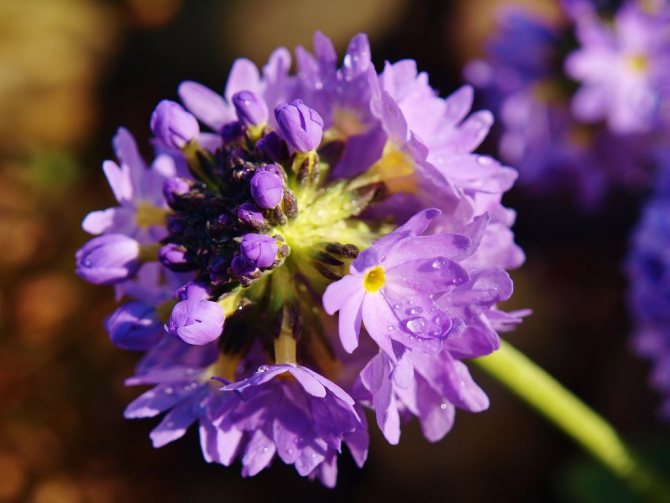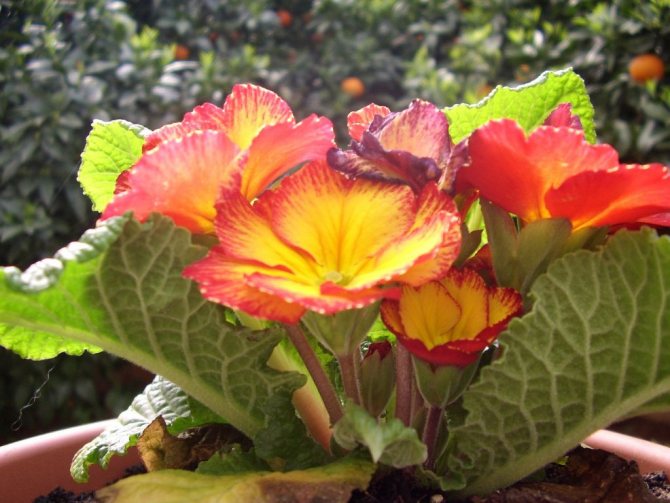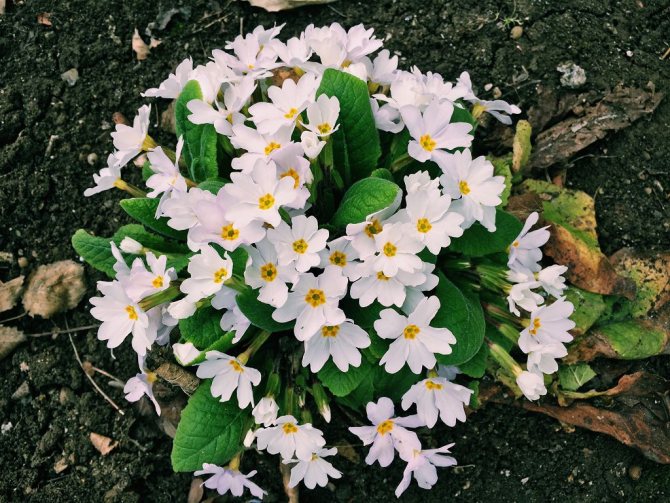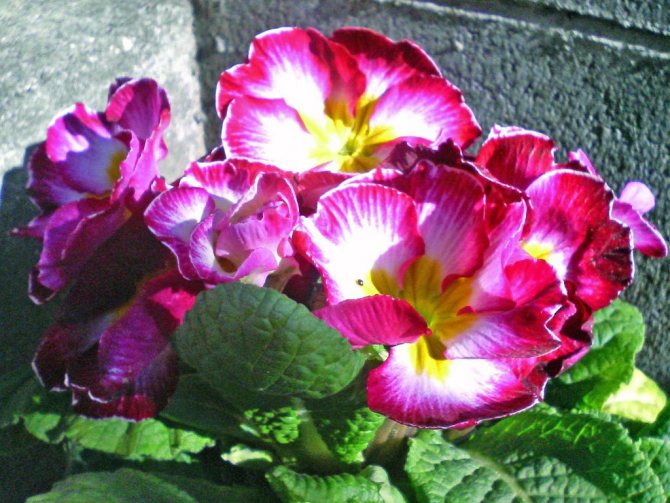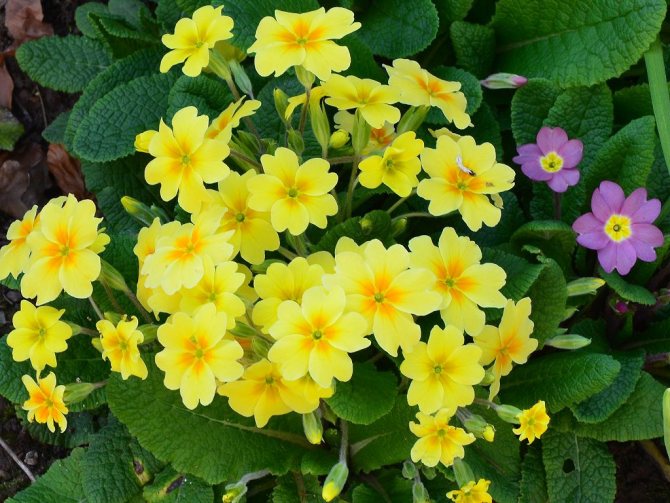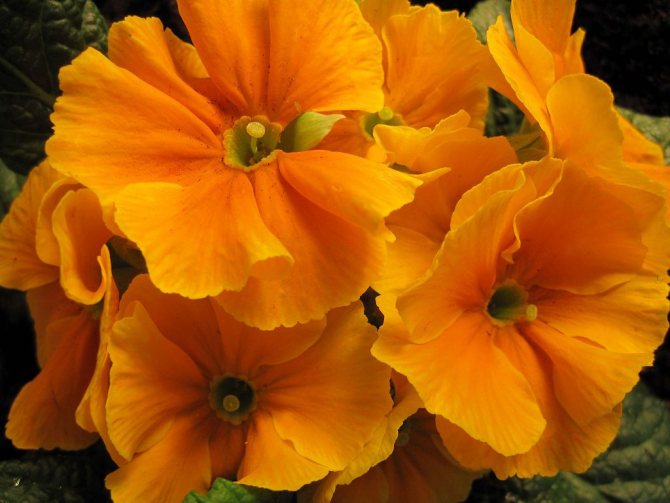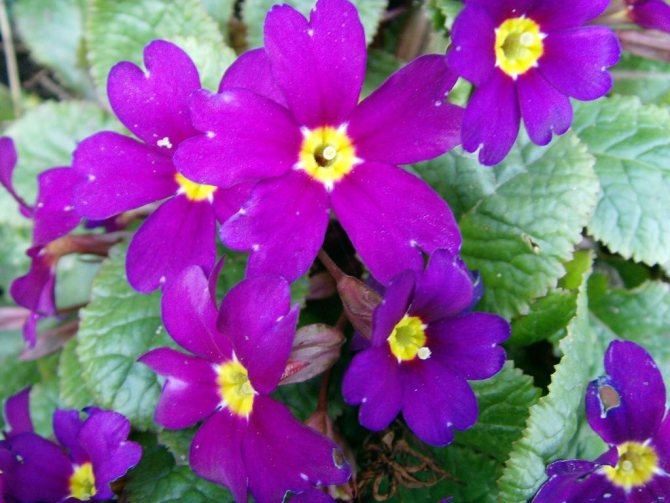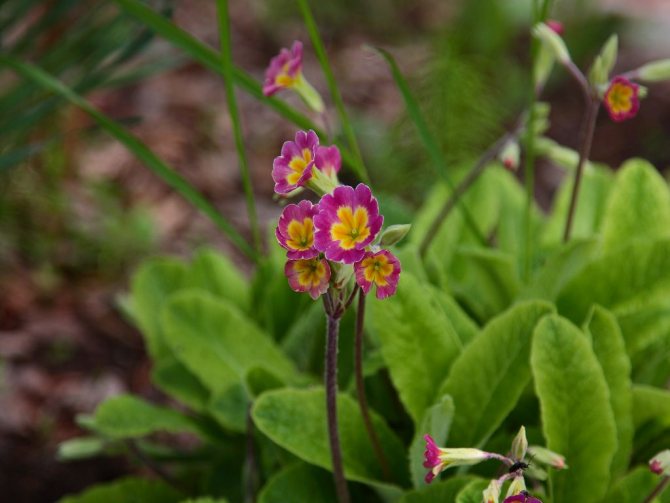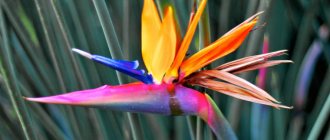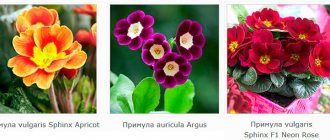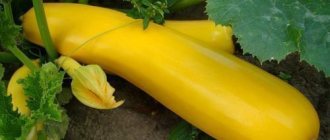Primroses (Primroses) are very beautiful, charming spring flowers popular with many gardening enthusiasts. Thanks to hundreds of varieties, you can create unusual compositions that decorate gardens, windows, balconies. This small plant does not need to spend a lot of time, and cultivation should not cause much trouble even for novice gardeners. We will tell you how the planting and care of the perennial primrose is carried out, photos of the species and varieties of this charming herald of spring will help you decide on the choice of varieties.
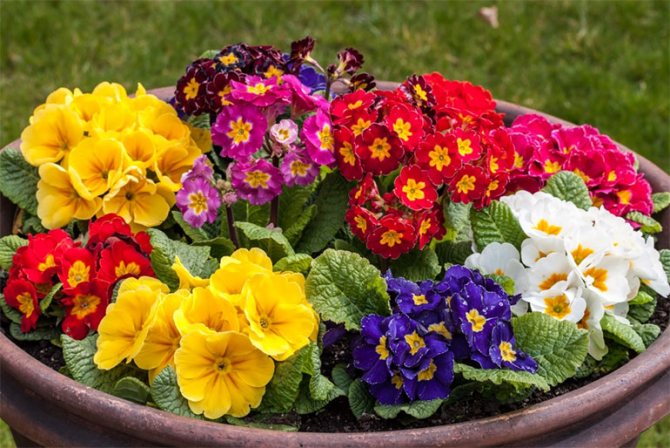
What it is?
Primula or primrose is a plant that got its name because of the early flowering period, before the snow melts.
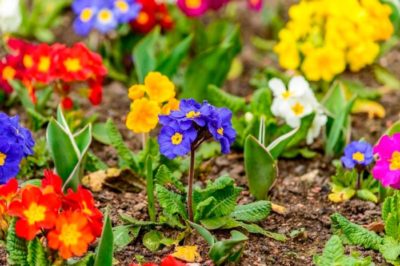

Primrose is basically a perennial, rarely biennial or annual plant with whole, wrinkled leaves forming a basal rosette. The leaves are pubescent. The flowers are five-membered, regular in shape, single or collected in racemose or umbellate inflorescences.
Most species of primroses are flowering low-growing grasses.... There are more than 500 species of primroses in nature.
Description of the plant
Primrose is a perennial, and occasionally an annual herb. It is compact in size. The height during the flowering period does not exceed 20-50 cm. The plant feeds on a fibrous branched rhizome, which is located in the upper layers of the soil. A dense leaf rosette forms immediately above the ground. It contains sessile or petiolate leaves of an oval, lanceolate or ovoid shape. They are painted in a gray-green shade without a pattern. The surface of the leaf is smooth or embossed, swollen between the veins. The edges of the leaves are solid or finely toothed. Due to the short nap, the foliage appears fluffy and soft.
A long, bare peduncle grows from the center of the rosette. Its top is decorated with a dense raceme or umbrella, although there are varieties with single flowers on short legs. Regular corollas consist of five oval petals with a rounded or, conversely, pointed edge. At the base, the petals grow together into a narrow, long tube, and sharply bend along the edge. The color of the flower is very diverse (monochromatic or variegated) - white, purple, lilac, pink and red. The center is almost always yellow. Flowers replace each other within 3-8 weeks.
After pollination by insects, oblong seed pods with soft edges ripen. The inside contains small, elongated seeds with a smooth dark brown or black surface.
Legends and mysterious stories
Attention: Translated from Latin, Primus means "first". The plant got its name due to the early appearance of flowers from under the snow that has not yet melted.
The plant is revered by residents of many countries. So, in Italy, primrose is called "the flower of the passion of Christ" and throughout the Holy Week the shroud and the altars of churches are adorned with flowers.
For the British, primrose is a sacred flower... There is a legend that the one who manages to get a red variety of primrose growing in a remote mountainous area and decorate his home with it will be immensely happy all his life. If an Englishman has a kindergarten, then a primrose must be there.
Auricula
These winter-green, cold-hardy primroses, generally referred to as auricular primroses, or simply auricles, are bred in Britain mainly under glass to protect them from damage by raindrops. Rosettes of wide, fleshy, pointed leaves, usually covered with a powdery bloom, if the plants are not divided, form dense thickets over time. In spring, flowers are formed, 2-20 in umbellate inflorescences on thick arrows up to 15 cm high. Corollas are mainly with a flat limb or slightly funnel-shaped, with concentric zones of different colors. The abundance and color of mealy plaque depends on which subgroup these varieties belong to - alpine, border, terry or exhibition. In the conditions of the middle zone, European auricul varieties have not been tested enough, although many of them are undoubtedly promising and fairly winter-hardy plants. Alpine auricles have no powdery plaque on either leaves or flowers. Around the central eye of the corolla there is a light zone (white, cream or golden), and behind it is a dark zone, often fading towards the edge.
"Valerie"
The variety is characterized by light corollas in the center, and closer to the edge from dark to light pinkish-purple;
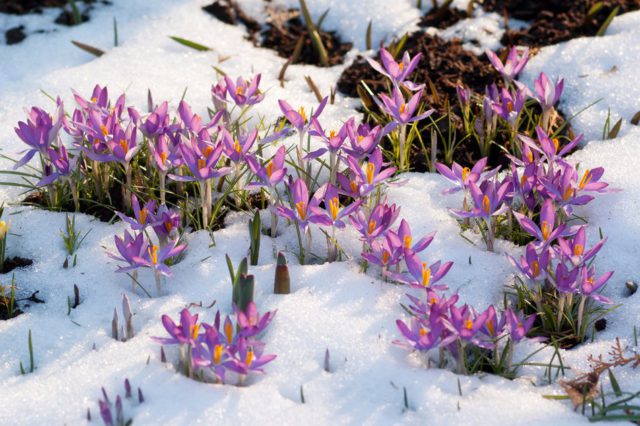

"Valerie"
"Winnifrid"
Corollas are golden with a crimson hue, lightening to bright scarlet.
"Winnifrid"
Description and photos of species and varieties
Room
The size of a room primrose usually does not exceed 25-30 cm. The main advantage of this plant is the flowers that form a dense cap. The color of the flowers is varied: yellow, blue, purple, pink, white, blue shades.
Abundant flowering is characteristic of the flower in winter and spring.... But with proper care, you can achieve year-round flowering.
The most common and favorite among flower growers are the following types of indoor primroses:
Soft-leaved
They are characterized by one basal rosette, light green, large, elongated leaves and inflorescences with 15-20 lilac, pink or red flowers. Peduncles are vertical. Flowering begins in early spring and lasts more than three months..
Reverse conical
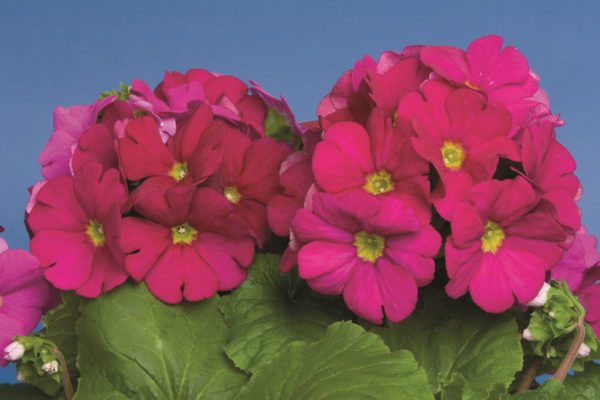

These primroses have elongated leaves of a beautiful emerald hue. Wavy along the edge. Peduncles are collected in umbellate inflorescences. The flowers are red, crimson, lilac, pink and white. The diameter of the inflorescences reaches 12 cm.
Common stemless
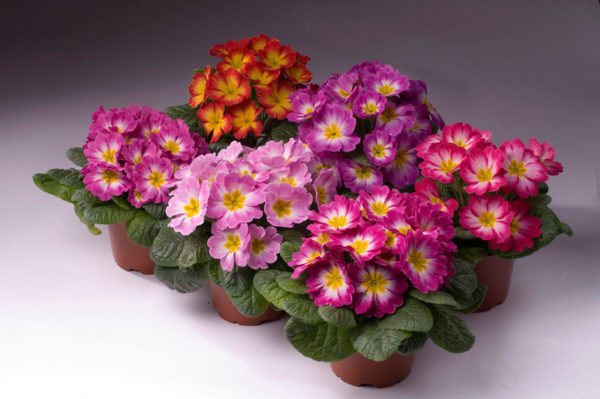

Miniature indoor species, not exceeding 20 cm in height. They have bright green leaves. Flowers are single, small, of various colors. Flowering begins in April and lasts four months.
Sadovaya
Of the many natural species in gardening practice, about a hundred are cultivated, as well as numerous hybrids bred by breeders. Severe climatic conditions with frosty winters are painlessly able to survive only about 30 varieties.
The most common species in our gardens are:
Ushkovaya
Easily tolerates severe winters and is undemanding to growing conditions... It has a dense rosette with fleshy evergreen leaves. Fragrant flowers are collected in an umbrella on a high peduncle. Blooms in May. Flowering lasts more than a month.
Ordinary
Winters well, easy to care for. It grows well, due to which it quickly forms a decorative pillow of double or simple flowers on low peduncles.
Fine-toothed
Characterized by spherical inflorescences and very early flowering lasting more than a month
Japanese
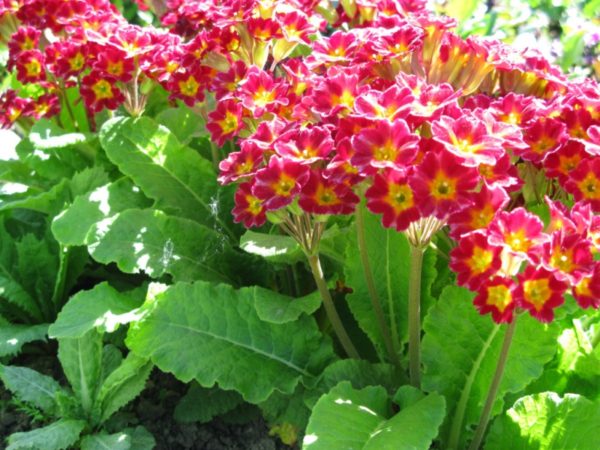

Refers to multi-tiered primroses. Flowers of various colors are arranged on the stem in several tiers. The plant prefers partial shade.
Florinda
A plant with 50-70 cm tall peduncles and inflorescences that look like hanging bells
Evening (Enotera)
This primrose has a straight, densely leafy stem up to 80 cm high. Flowers are yellow, four-petalled. This variety got its name because the flowers open in the evening and close in the morning.
Watch a video about the features of evening primrose (evening primrose):
Perennial
The advantages of perennial primroses are early and abundant flowering, a variety of colors, a pleasant aroma and winter hardiness. If you collect a collection of different species, you can enjoy the flowering of primroses all year round... There are varieties that bloom twice a season - in spring and autumn.
With a compound inflorescence
Umbrella primroses differ from other groups in the height of the peduncle, branching according to the number of flowers and forming an umbrella, towering above the green mass.
The group of primroses, which have a complex umbrella inflorescence, include the following types:
Primrose tall
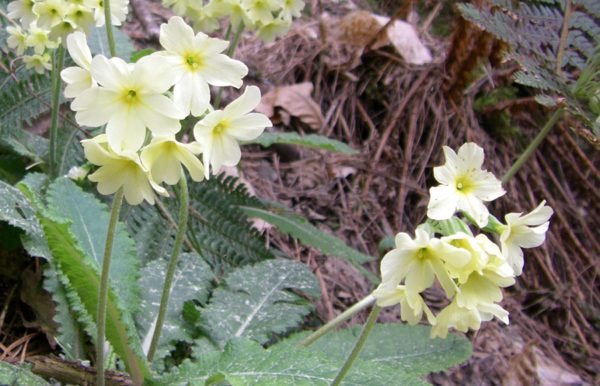

Mostly blue or white. Blooms in late April - early May.
Pink
In the pink primrose, flowers of an unusual pink color first appear, and then serrated leaves that form a basal rosette.
Grandi flora
Large-flowered variety of primroses... Feels good on peat soils and near water bodies.
Spring
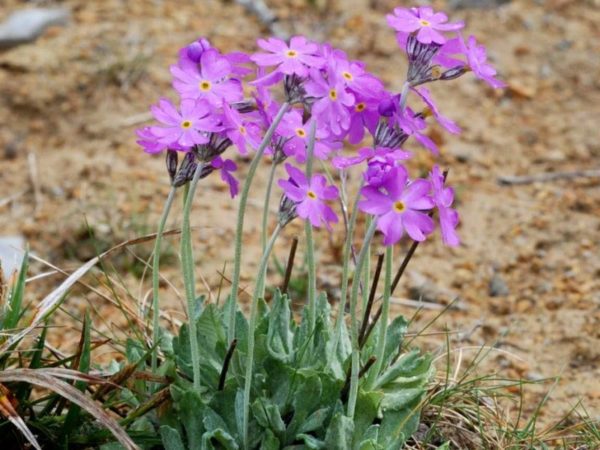

Umbrella inflorescences of this primrose can have white, yellow, cream, pink, purple petals.
Requirements for the landing site, soil
When choosing a landing site, you need to make sure that the position is semi-sunny, without the scorching sun. In order for primroses to grow well, to bloom for a long time and abundantly, they should be planted in sufficiently illuminated places in spring, and in summer, plants need to be provided with partial shade (for example, under deciduous trees). In summer, primrose leaves are sensitive to the bright sun. Only the following types of primrose can be grown in sunny places:
- Plain or stemless,
- Spring,
- Julia's primrose,
- Florinda primrose.
It is important to provide the plants with a constantly moist soil. The soil needs fertilized, fertile, humus, moist, loamy. The soil for cultivation must be sufficiently heavy, containing humus.
Peat substrate is necessary for the following types of primrose:
- mealy,
- Japanese,
- Florinda.
In soil containing calcium, primroses should be planted:
- auriculate,
- pubescent.
Light, humus-rich soil with calcium requires a cortical primrose.
Use in landscape design
Primrose is gaining popularity among landscape designers due to its ease of growing. With the correct selection of the varietal composition, the primrose flower garden will be decorative from mid-spring to late summer. Most often, the following objects are decorated with primroses:
- Shores of artificial reservoirs... This is the most suitable place for placing moisture-loving primrose varieties.
- Curbs and paths... Varieties of bright colors look especially organic in this quality.
- Rock gardens and rockeries often decorated with primroses due to their undemandingness to the ground and lighting.
Curb primroses
Most of these relatively large plants native to the Himalayas and East Asia form rosettes with a diameter of at least 20 cm. The leaves are 10–20 cm long, and the flowers are in umbrellas, racemes, or whorls (candelabra type). Some species prefer swampy conditions, others just a good moisture-retaining soil rich in humus. They need a good microclimate in the garden. All of them, unless otherwise indicated, bloom from late spring to mid-summer. Winter hardiness is not always satisfactory. In the middle lane, in unfavorable winters, they grow out.
P. alpicola (P. alpine)
Forms umbrellas of fragrant drooping funnel-shaped flowers. Corollas with a mealy bloom are white, cream, yellow or purple. Narrow oval leaves die off for the winter. The height and diameter of the plant is 15-40x20 cm.
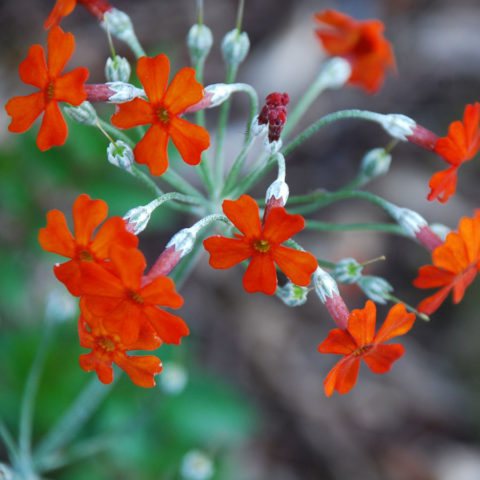

Umbrellas of fragrant drooping funnel-shaped flowers
P. aurantiaca (P. orange)
Candelabra look with deep brownish orange flowers on dark purple arrows. Leaves dying off for the winter are oval, dark green, with a light powdery bloom, often with a purple midrib. Dislikes sandy soils and grows better on loamy. Winter hardiness in the middle lane is satisfactory.The height and diameter of the plant is 30x20 cm.
Candelabra look with deep brownish-orange flowers
P. beesiana (P. Biss)
Candelabra species with dense pink yellow-eyed flowers on mealy shoots. The leaves are semi-green, wide, finely toothed. Winter hardiness is poorly understood. The height and diameter of the plant is 30x20 cm.
Candelabra view
P. bulleyana
Candelabra look with red buds and golden yellow flowers. The leaves are semi-green with a lilac midrib, and the stems are white-fruited. The height and diameter of the plant is 50x20 cm.
View with red buds
P. burmanica (P. Burmese)
Candelabra view with leaves dying off for the winter and purple flowers with an orange eye. Withstands frosts not lower than -23 ° С. The height and diameter of the plant is 30x20 cm.
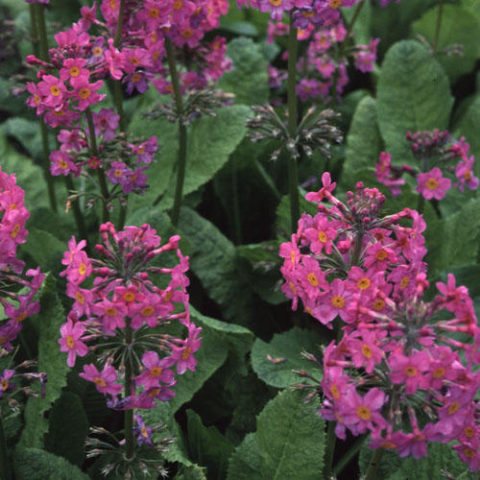

P. burmanica
P. chungensts (P. chungen)
Powerful candelabra species with uneven, dying off for the winter leaves, red buds and small fragrant pale orange flowers. Insufficiently tested in the middle lane. The height and diameter of the plant is 60x20 cm.
P. chungensts
P. cockburniana (P. Cockburn)
Forms small whorls of orange-red flowers on white arrows. Beautiful, but very short-lived specimens with leaves dying for the winter. Easily propagated by seeds. Withstands frosts around -20 ° С. The height and diameter of the plant is 25x15 cm.
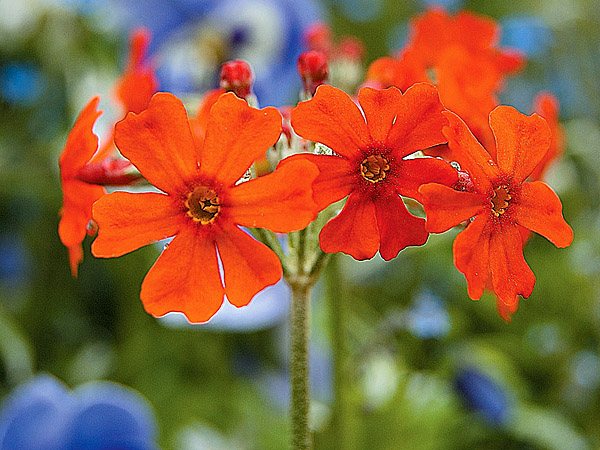

Whorls of orange-red flowers
P. denticulata (P. fine-toothed)
From early spring to early summer, it forms dense globular umbrellas of flowers, the color of which varies from pink to purple, lavender and red, with yellow eyes in the center. Leaves dying off for the winter are finely toothed, slightly hairy. Easy to breed, recommended for border edges or gaps between shrubs. One of the most common and reliable species grown in central Russia. The height and diameter of the plant is 40x20 cm.
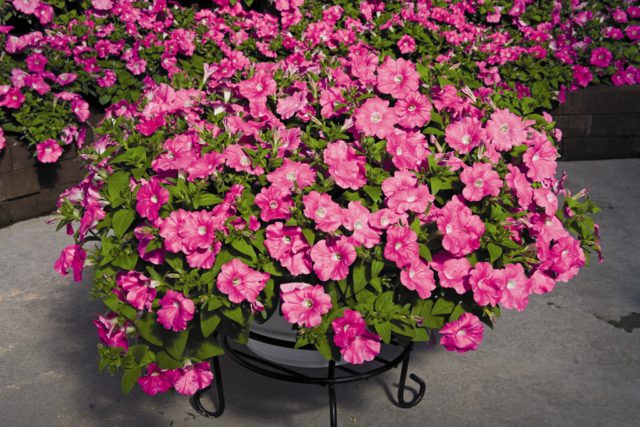

Dense globular umbrellas of flowers
P. elatior (P. high)
In the second half of spring, forms funnel-shaped yellow flowers - up to 10 in one-sided umbrellas. European species with deep venation of hairy, semi-green, serrated leaves. It takes root well on lawns. Winter hardiness in central Russia is good. The height and diameter of the plant is 15x20 cm.
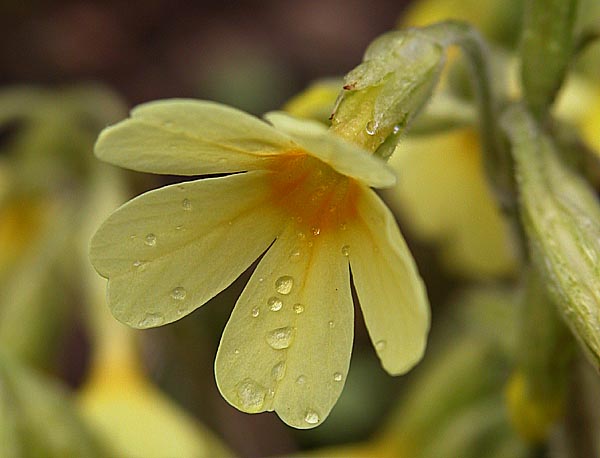

Funnel-shaped yellow flowers
P. florindae (P. Florinda)
In July-August, it forms strong peduncles with large umbrellas of fragrant drooping bell-shaped flowers of yellow color. Great view requiring very damp conditions. Leaves die off for the winter. In central Russia, it is not stable enough - it dies off 3-4 years after planting. The height and diameter of the plant is 80x30 cm.
Strong peduncles with large umbrellas of fragrant drooping bell-shaped flowers
P. helodoxa
Strong candelabra primroses with leaves dying off for the winter and whorls of very bright flowers in different shades of yellow, orange, red and pink. The height and diameter of the plant is 50x20 cm.
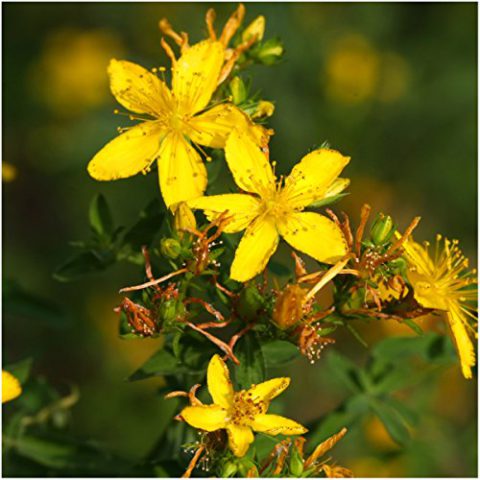

Strong candelabra primroses
P. "Inverewe"
A powerful semi-evergreen candelabra hybrid with bright orange-red flowers. The height and diameter of the plant is 75x60 cm.
Powerful semi-evergreen candelabra hybrid
P. ioessa
In early summer, it forms umbrellas of large fragrant drooping flowers with funnel-shaped cream or purple corollas. Leaves die off for the winter. The height and diameter of the plant is 25x15 cm.
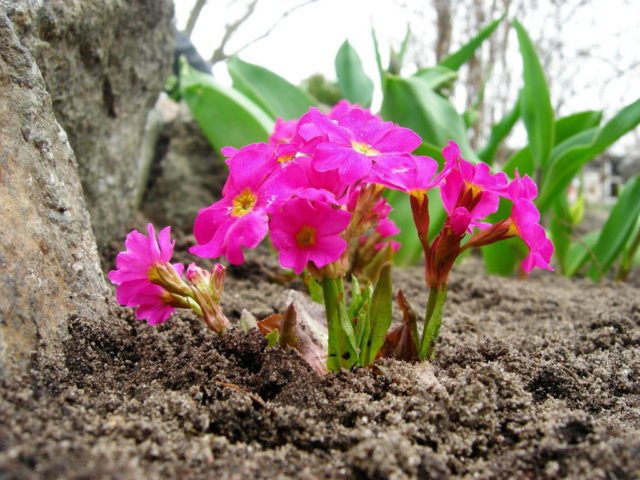

Umbrellas of large fragrant drooping flowers
P. japonica (P. japanese)
Candelabra appearance with purple, sometimes white or pink, dark-ocellous flowers on a green or reddish arrow. The leaves are pale green, uneven, dying off for the winter. An easy-to-grow primrose that does not require particularly moist soil. This species is widespread in the middle lane, although it needs a warm microclimate in the garden area. The height and diameter of the plant is 40x20 cm.
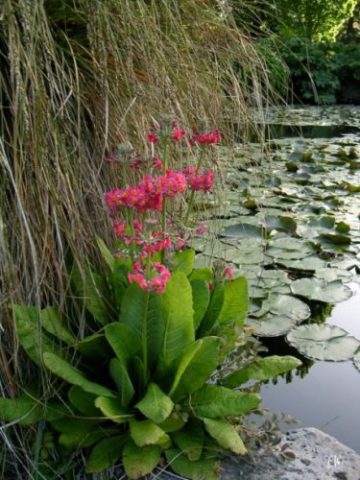

Candelabra view with purple flowers
"Fuji"
The variety has white corollas;
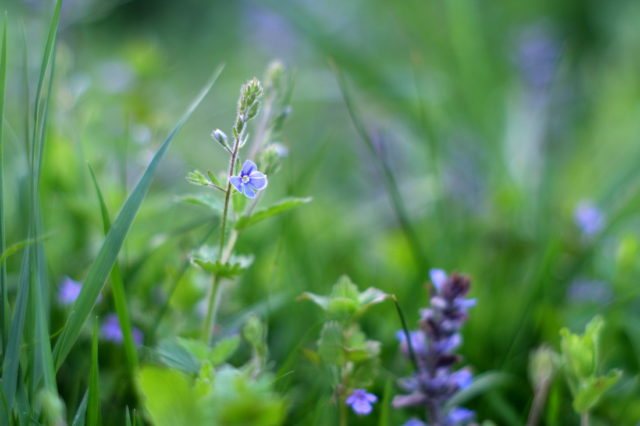

"Fuji"
Miller's Crimson
Corollas are dark red.
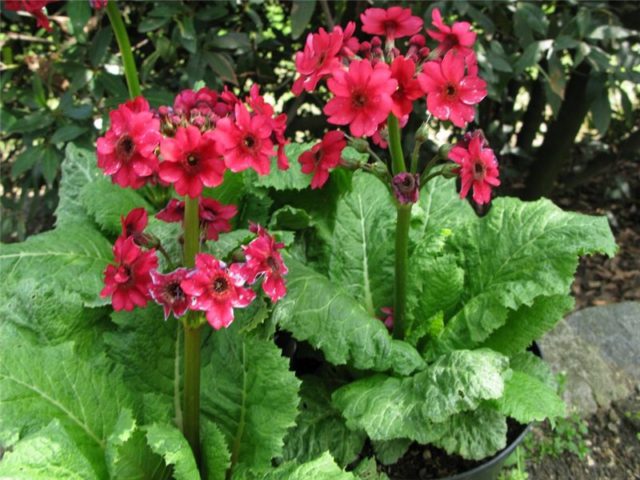

Corollas dark red
Postford White
Easy-to-cultivate, seed-propagated variety, forming large, white corollas with a yellow eye.
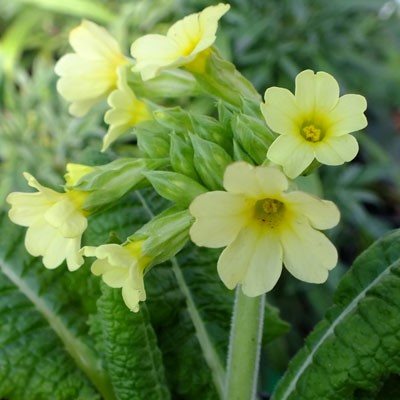

Postford White
P. Httoniana
Densely purple flowers with a yellow or white eye are collected in 2-6 whorls. Winter-green look with emerald leaves. Winter hardiness has not been studied enough. The height and diameter of the plant is 40x20 cm.
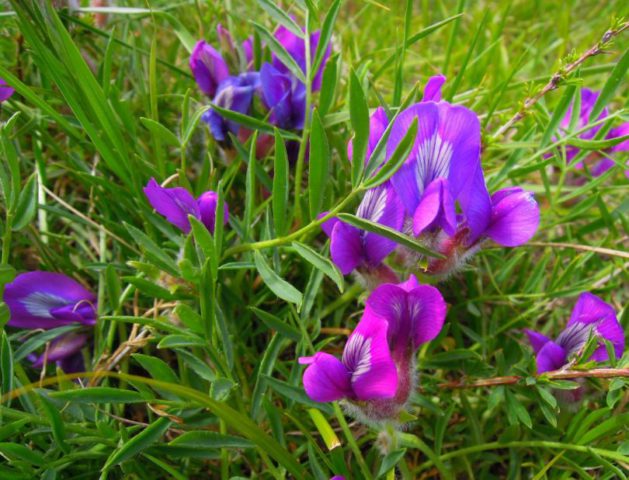

Deep purple flowers
P. polyneura (P. multicore)
In early summer, it forms umbrellas from pale pink to crimson flowers with a greenish-yellow eye and cut out lobes of the limb. Leaves dying off for the winter are dark green, lobed, hairy, like arrows. Prefers woodlands. The height and diameter of the plant is 40x20 cm.
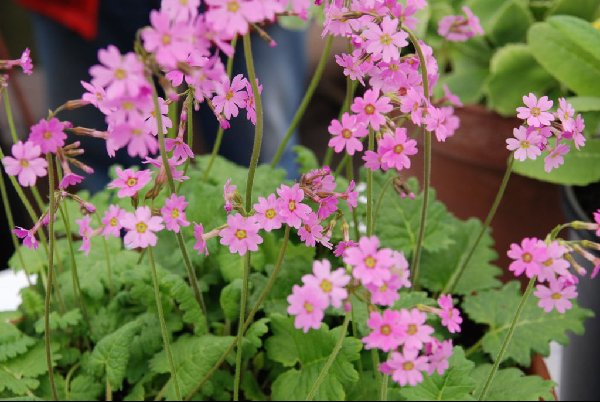

Umbrellas from pale pink to crimson flowers
P. prolifera (synonym of P. helodoxa) (P. offspring, P. marsh)
Candelabra look with slightly drooping, fragrant bright yellow flowers on short stalks. The leaves are dark, winter-green. The height and diameter of the plant is 60x20 cm.
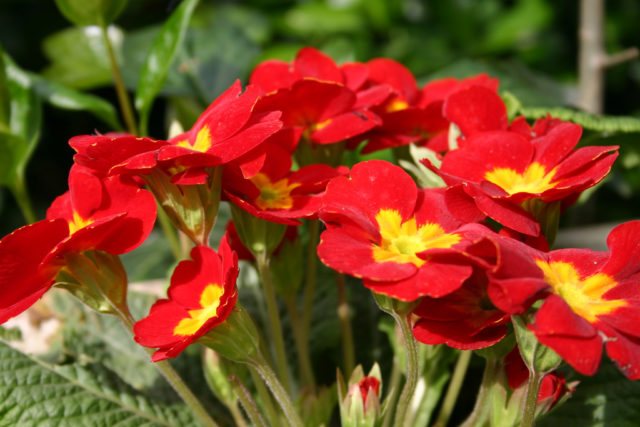

Leaves are dark, winter-green
P. putverulenta (P. powdered)
Forms spreading whorls of deep purple flowers with a dark eye. Leaves dying off for the winter with an uneven edge and a pale midrib. The most powerful and durable of the candelabra primroses with eye-catching white arrows. The height and diameter of the plant is 80x20 cm.
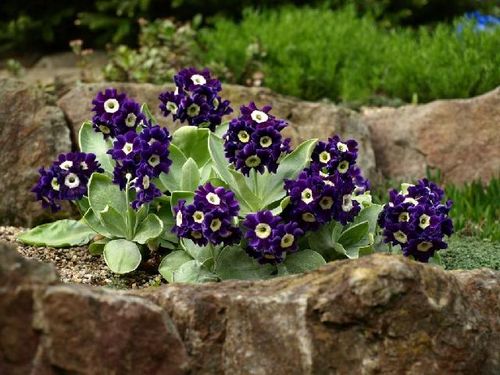

Forms spreading whorls
Bartley
Hybrids form flowers of different shades of pink and purple with a pale or dark eye.
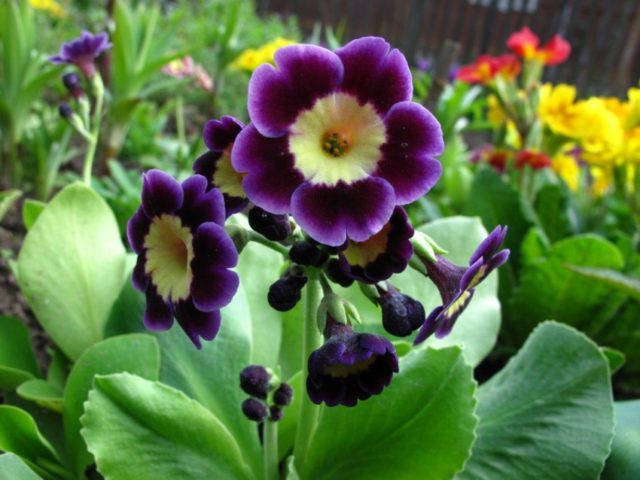

Bartley
P. rosea (P. pink)
In late spring, it forms umbrellas of large bright pink flowers with a yellow eye. A swampy species with glossy oval leaves dying off for the winter. Recommended for the outskirts of ponds, where it goes well with marigolds, lysichitones and other moisture-loving herbs. Relatively hardy species for the middle lane. The height and diameter of the plant is 15x20 cm.
In late spring, forms umbrellas of large bright pink flowers
"Grandiflora"
The variety has especially large corollas.
"Grandiflora"
P. secundiflora (P. bokosvetnaya)
Gustolilovye funnel-shaped drooping flowers are collected in a one-sided group, sometimes divided into 2-3 whorls. Leaves are smooth, narrow, winter-green or semi-winter-green on white mealy petioles. Easy to breed and withstands drier conditions than other curb primroses. Winter hardiness is not well understood. The height and diameter of the plant is 40x20 cm.
Gustolilovye funnel-shaped drooping flowers
P. sieboldii (P. Siebold)
Forms umbrellas of large flowers of different shades of pink and purple with a white eye. Lobes of the limb are usually cut or fringed. Sprawling rhizome primrose with light green oval hairy leaves dying off for the winter, the edges of which are wavy-obtuse. The species itself and its varieties easily take root and look great on raw mixborders in the shade of rhododendrons and other forest bushes. Homeland is the Far East of Russia. Winter hardiness in the middle lane is high. One of the most reliable types of this group. The height and diameter of the plant is 20x20 cm.
One of the most reliable types of this group
Dancing Ladies
The variety has pale pink or white corollas above and pink, sometimes blue below.
Landing
In a home environment, planting primroses requires compliance with a temperature regime ranging from +18 to +21 degrees from spring to mid-autumn. Indoors, during the flowering period of primroses, it is necessary to maintain high humidity.
At home
- Seeds are sown in a low, spacious container, sprinkled on top with a thin layer of nutritious soil mixture.
- Planting is moderately watered and placed in a cool, dark room.
- From above, the container is covered with polyethylene or glass, the plantings are periodically watered.
The first shoots can be observed in 2-3 weeks.... After 1.5 months, the sprouts can be transplanted into pots as independent plants.
Watch a video about planting primrose seeds at home:
On the street
You can plant a plant both in spring (in the last days of May) and in autumn. A shaded area is chosen as a landing site. The soil should be loose, drained and breathable. Large varieties require a planting interval of 25 cm, small ones - 15 cm. There should be no extra space between plantings, primroses prefer thickening.
Read more about the features of planting primroses on the street or at home and further caring for flowers in this material.
Small but strong plant
Under natural conditions, primrose is usually found in the mountains (in Europe, Asia), in areas with a temperate climate. This small plant can withstand over 20 degrees of frost. It is considered a harbinger of spring, but flowers appear after the snowdrop. Snowdrops are visible when winter has not yet gone, they often grow out of the snow. Primroses can appear in about 1.5-2 weeks later, at the end of February. The timing depends on whether the winter is warm enough.
Legends say that primrose appears in our country when birds begin to fly away from warm countries. When they arrive, the primrose is already in bloom.
Perennial garden primrose usually blooms from March to July. In our country, there are a dozen species of this plant, although there are about 400 of them.
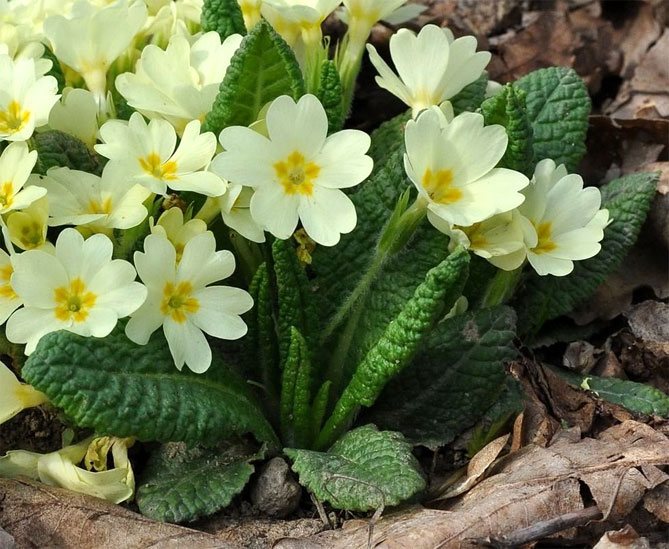

A characteristic feature of all types of primroses is rosettes of green, rather thick leaves, from which multi-colored inflorescences grow. Primrose usually has pink, white, purple, yellow flowers. The height and type of flowers depend on the cultivar. The most popular common primrose grows up to a maximum of 20 centimeters, with a ball of inflorescences consisting of flowers of various colors with a yellow center. There are species of smaller and larger sizes (up to half a meter), with spherical inflorescences in different colors, with a white or yellow center. New varieties are constantly being created, due to which the variety of primroses is constantly growing.
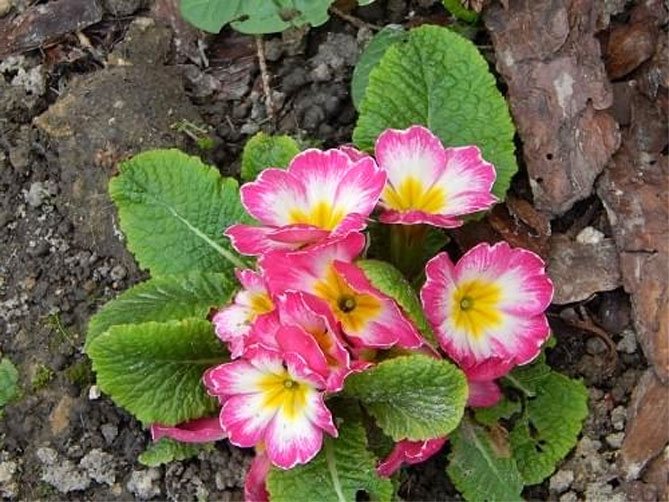

The hairs on primrose leaves contain chemical compounds that cause allergic rashes in many people.
The flowering period of the plant mainly occurs in the spring months - March, April. Sometimes flowering continues until summer. Primroses are very widely used - they can be grown in containers, pots. They are often found in rock gardens, as well as in rocky gardens, flower beds, used to create flower borders.
Our grandmothers made an infusion of primrose, which helps with colds, strengthens the immune system.
Features of caring for a houseplant
For a home primrose, certain conditions must be organized:
- Nutritious, loose, breathable soil.
- Bright but diffused color.
- Cool during bud formation.
- Additional air humidification.
- Constant maintenance of the earthen coma in a moist state.
- Top dressing in the period preceding flowering.
Watch a video about caring for room primrose:
Seed storage
It is important to store purchased seeds only for the recommended shelf life, after their germination will be reduced to zero. Purchased primrose seeds are the preferred option as they do not have to worry about their viability. Do not allow low temperatures or excessive humidity in the place where the seeds are stored.
Perennial primrose after flowering
Primrose requires attention not only in spring and summer, but after the end of the flowering period. It needs to be properly prepared for wintering and help to survive the cold.
Autumn care
Over the summer, the rhizomes grow and can be exposed. Therefore, after flowering, under the shrubs, you need to add loose soil a few centimeters thick. This will prevent the root system from freezing and drying out. You can feed the plant with a small amount of potassium-nitrogen fertilizer.This will allow it to build up green mass over the winter.
Wintering
It is necessary to shelter primrose for the winter only if the climate in the region is harsh. If the air temperature drops below 20 degrees, then the bushes are covered with a thick layer of straw or dry leaves. In early spring, the shelter is removed and the flower is allowed to actively develop.
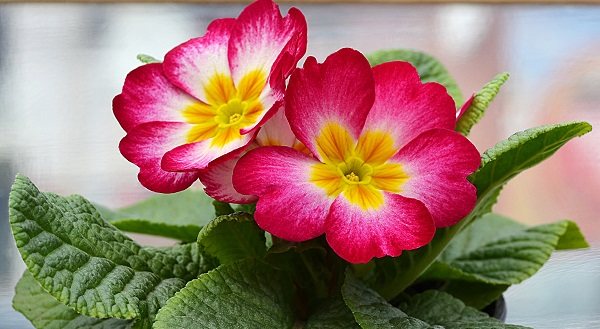

Moving
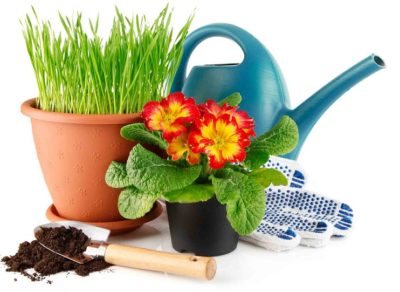

A young primrose requires a mandatory annual transplant, with getting rid of the old soil, an adult plant - once every 2-3 years. When transplanting, the plant is not buried. The socket must remain on the surface. The main method of transplanting primrose is transshipment, thanks to which the fragile root system is practically not injured. The transplant can be combined with the separation of young shoots. It is carried out in late September - early October (learn about transplanting and caring for garden primrose in autumn here). Watch a video about the correct primrose transplant:
Outdoor care
When caring for primrose, it is necessary to take into account its varietal characteristics. Despite the variety of varieties, primroses growing in temperate latitudes are unpretentious. Most prefer coolness and feel comfortable at a temperature of + 15-18 degrees.
Watering
This is a moisture-loving flower. It should be watered during the growing season at least 2 times a week. If it is hot and dry outside, then increase the number of waterings. Moisture should not be allowed to stagnate. It is also best to avoid getting water on the leaves.
Reproduction
In addition to seed propagation, primrose can be bred using cuttings and dividing the bush:
- Division of the bush. It is better to spend it in spring or autumn every 4-5 years. It is advisable to divide the bush after flowering, but not necessary. Carefully dig up the plant, divide into equal parts and plant.
- Cuttings. You can root any part of the primrose. Choose a suitable stalk (you can also part of the leaf), put it in water. When the roots appear, transplant into a suitable soil. When transplanting the cuttings into the ground, it is necessary to cover for some time with glass or film, so that they take root faster. Seedlings can be transplanted into the open ground in a year.
Top dressing
It is recommended to regularly feed perennial primrose with mineral fertilizers. But make the concentration of the solution 2 times weaker than indicated in the instructions. Until the end of flowering, you need to fertilize the culture weekly. It is advisable to make more potash and phosphorus fertilizers. They stimulate flowering. You need to be careful with nitrogen fertilizing. They form a lush green mass.
Bloom
The shapes, sizes and shades of primrose flowers can be very diverse. They are solitary, collected in spherical, umbellate and other inflorescences.
Although primrose is considered a spring flower, the timing of its flowering may differ from species to species:
Reproduction
To get new primrose bushes, the following methods are suitable:
- Sowing seeds - provides for the use of quality planting material. Sowing takes place at home, followed by transplanting the shoots, if necessary, into open ground.
- Socket division - the most popular way due to its simplicity. For reproduction, it is enough to divide the primrose bush into groups or rosettes with a knife.
- Rooting - represents the immersion in the ground of a cutting with an axillary segment bud.
For more information on primrose breeding and subsequent care, read this article.
Growing seedlings from seeds
This is the most popular way to breed primrose. Thanks to seed reproduction, you can grow the rarest and most unusual varieties of flowers on your site. Seeds sown for seedlings allow the plant to form stronger and transfer the transplant to open ground without any problems.
Landing dates
Taking into account the long preparation of the seed and the rather slow sprouting, sowing must be started in advance. For seedlings, it is best done at the beginning of winter.But some hybrids grow faster, they can be sown in February-March. Prepared seedlings in open ground are planted only in the second year of life in the spring, as soon as the snow melts (in March-April) or at the beginning of autumn.
Capacity and soil
Containers for sowing seeds should be shallow. These can be peat tablets, pots, containers. Line the bottom with polyethylene. Make several holes in it. The containers themselves must also have holes so that water can drain through them.
The soil needs light, nutritious, good moisture retention. Structure:
- turf (1 part),
- sheet land (2 parts),
- sand (1 part).
You can add sphagnum. Saturate the drainage layer to the bottom. Before sowing, the soil must be calcined for 20 minutes in the oven to disinfect.
Seed preparation and planting
Seeds are used only fresh, better collected on their own. Most varieties of primroses require seed stratification (cooling) for good germination. Before sowing, they are placed in a refrigerator or on a balcony at a temperature of + 5-7 ° C. They should be kept there for 2-4 weeks. You can keep the seeds for several hours in the cold, then warm. And so repeat 5 times. Stratification is not necessary for breeding varieties.
To make the seeds germinate faster, they are soaked in aloe juice for 20-30 minutes. Then the dried ones are sown. Spread evenly over the surface of the moistened substrate. Small-seeded primroses are sown on a thin layer of vermiculite. No more than 5 seeds should be consumed per 1 cm2 of soil. If they are large, then they need to be placed at a distance of 1.5 cm from each other. When sowing in peat tablets, sow 1-2 seeds. Compact the soil slightly and spray with water. Cover the container with foil and place in a bright place, but without direct sun. Moisten the soil periodically with a sprayer. If there is a pallet, then pour water into it, but drain the excess. Remove the film periodically to remove condensation.
How to care for seedlings
Seeds germinate well at a temperature of + 15-18 degrees. Seedlings may appear as early as 2 weeks after sowing. Then the cover from the film can be removed. When 2 full-fledged leaves appear, the seedlings dive into separate pots, into a loose light substrate. Weak specimens are removed. Once a month, the sprouts are fed with mineral fertilizers of low concentration. Water the seedlings sparingly, without overflowing. Daylight hours for seedlings should be at least 10 hours. If necessary, make additional illumination with fluorescent lamps. As it grows, the plant is transplanted into a larger container using the transshipment method.
Planting seedlings in open ground
Seedlings are ready for planting outdoors when they grow up to 10-20 cm. It can be planted only at 2 years of age in spring or autumn in a shaded place. Make holes of such a size that an earthen ball with a root system fits in them. You can make more depth and put rotted manure on the bottom.
Place the seedlings vertically in the hole, sprinkle with soil and water at the root (3 liters of water per 1 m2). Deepen the root collar. There should be a distance of 20-70 cm between each hole, depending on the type of flower. From above, mulch the soil with sawdust, needles or peat so that moisture remains.
Do you know how to grow other perennials on the site? Learn about the nuances of outdoor care for anemones.
The rules for growing perennial lobularia in personal plots and flower beds are written on this page.
Germinating seeds
Using seeds as planting material, flowering can be expected only five months after germination. Primrose bushes grown from seeds are no different from mother plants.
Advice: If you plan to grow a flower at home, you can stop at the seeds of common primrose.
In addition to seeds, a soil mixture of the optimal composition is selected.... Containers with crops are placed in a cool room with a temperature not exceeding 10 degrees.
Learn more about breeding a herbaceous beauty from seeds here.
Reproduction methods
Primrose is grown from seed and propagated by dividing the bush and leafy cuttings. It should be noted that when sowing self-collected seeds, the varietal properties of especially terry primroses are not preserved. The seeds themselves quickly lose their germination, so they are sown as early as possible.
Seedlings should be grown first. To do this, in mid-February, shallow boxes are prepared with a mixture of turf, sand and leafy earth. They try to distribute small seeds evenly on the surface. They are only slightly pressed into the ground. To preserve moisture, the container is covered with foil and placed in the freezer for 25-30 days. You can take the box outside. The air temperature during this period should be at -10 ° C.
After stratification, the frozen seeds are transferred to a lighted windowsill, in a room with a temperature of + 16 ... + 18 ° C. Seedlings do not appear quickly and unevenly. When the seedlings are 2 weeks old, the cover is removed. Plants with 2-3 true leaves dive into another box with a greater distance. As they grow, several more picks are carried out. For open ground, primrose seedlings will be ready only after 2 years.
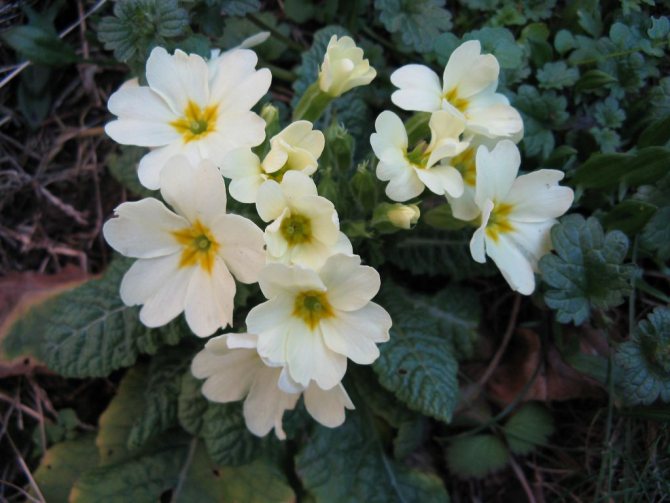

It is recommended to divide a bush 4-5 years old into several parts. This allows not only to get more plants, but also to rejuvenate the existing ones. They do this in August-September. Previously, the plants are well watered, dug up and carefully freed from the ground. The roots are washed in warm water, and then the plants are cut with a knife into divisions with 1-2 points of growth. The cuts are treated with charcoal and the flowers are immediately planted in a new place.
For grafting, a leaf with a petiole and a bud at the base is used. It is rooted in a sandy-peat substrate. In this case, half of the sheet plate is immediately removed. The stalk should be kept in a warm (+ 16 ... + 18 ° C) room with bright but diffused light. The appearance of new buds indicates successful rooting. After that, the cuttings are transplanted into separate pots with soil for adult plants. In the spring they can be sent to the garden.
Useful properties, use in treatment and contraindications
- Evening primrose oil is used to treat bruises, wounds and burns.
- Decoctions of the plant are taken for rheumatism and headaches.
- The roots of the plant have a diuretic and diaphoretic effect, increase the secretion of the stomach, and activate metabolism.
- Tea is made from dried flowers to strengthen the immune system.
- The British eat young primrose leaves as a salad, and the roots are used as a spice and as a medicine for tuberculosis patients.
The use of any preparations based on primrose requires prior consultation with a doctor.... Contraindications for the use of primrose are:
- pregnancy;
- the presence of peptic ulcers;
- individual intolerance.
Potted primroses
These thermophilic forms are bred as annuals in greenhouses, greenhouses and dwellings to create winter-spring flower arrangements. They are often sold in pots at flower shops as gifts.
P. kewensis (P. kewskaya)
Fragrant pale yellow saucer-shaped flowers with a diameter of 2 cm are collected in several whorls. Leaves are winter-green, from oval to spatulate, with a light white powdery bloom. The height and diameter of the plant is 30x25 cm.
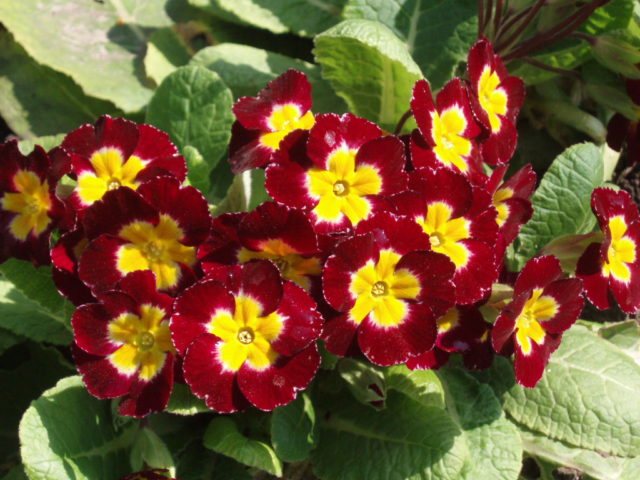

Fragrant flowers
P. malacoides (P. soft)
Forms whorls of 4-6 small, sometimes double flowers of different shades of red, pink, purple or white with a yellow eye. An easy-to-breed species, usually grown as an annual, with oval hairy winter-green leaves. The height and diameter of the plant is 30x20 cm.
Easy to breed
"Bright Eyes"
Flowers of the variety are varied in color. Their corollas have a wide contrasting dark eye and sometimes a yellow throat.
The flowers of the variety are varied in color
"Carmine Pearl"
Dwarf primroses 15-20 cm high with carmine corollas.
Dwarf primroses
"Fire Chief"
The flowers are brick-red;
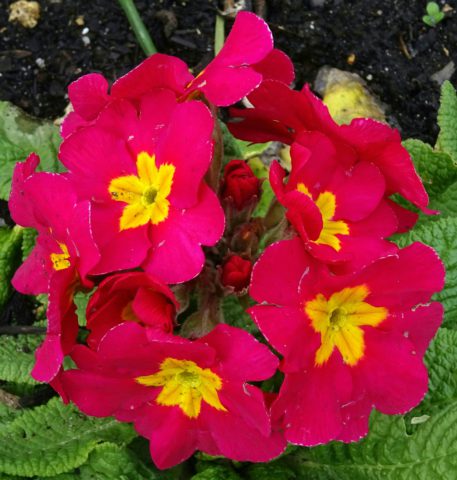

Brick red flowers
"Jubilee"
The flowers are cherry red;
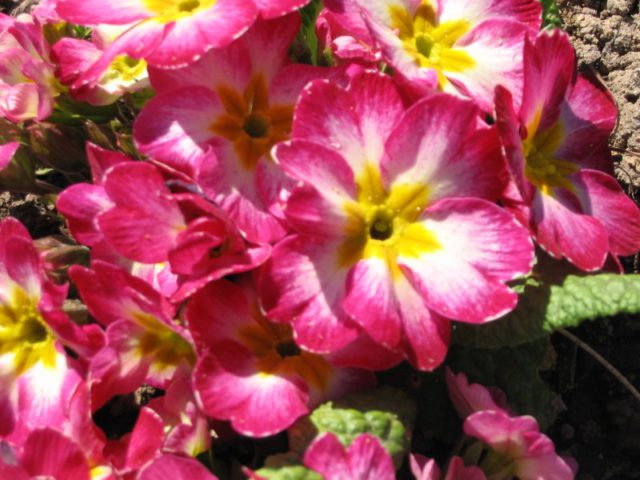

Cherry red flowers
"Lilac Queen"
Terry, non-lilac flowers.
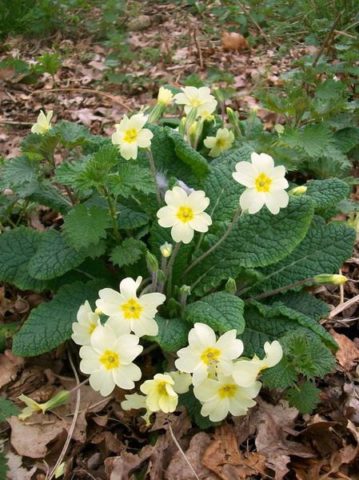

Terry, soft-leaved flowers
"Mars"
A variety of this primrose with a height of 12 cm with dense lavender corollas;
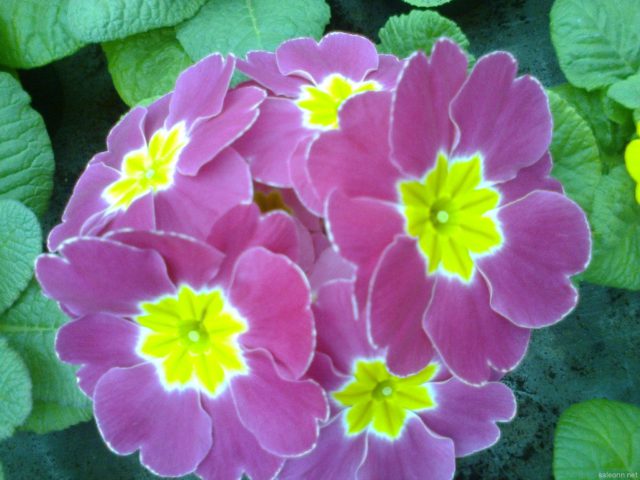

Variety with dense lavender corollas
"Ninette"
A variety of rich crimson color;
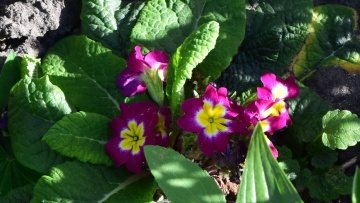

A variety of rich raspberry color
Rose Bouquet
Densely carmine flowers.
Densely carmine flowers
P. obconica (P. inverse conic)
The variety forms large umbrellas of flowers with a diameter of 2.5 cm. Their color ranges from white, pink, red, pale lavender to deep purple, always with a greenish eye. It is one of the most popular potted varieties in winter. The height and diameter of the plant is 30x20 cm.
The variety forms large flower umbrellas
"Caerulea"
Blue-purple flowers;
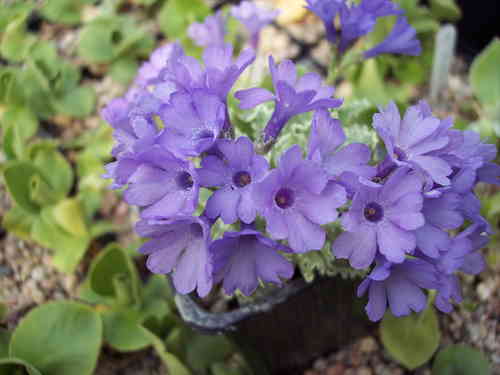

Blue-purple flowers
"Giant White"
Large, pure white flowers;
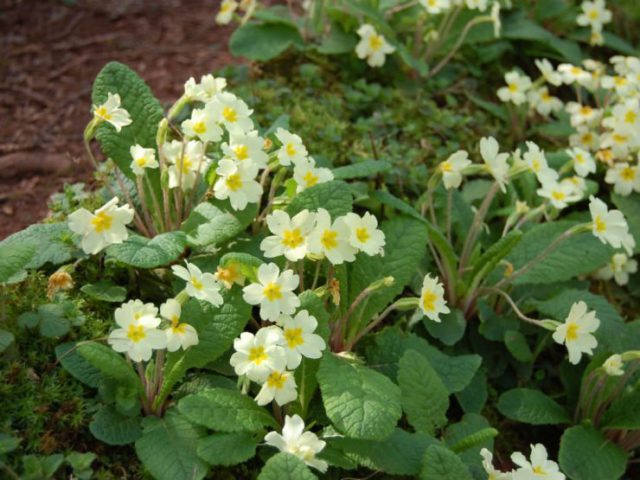

Large, pure white flowers
"Salmon King"
The cultivar forms reddish-orange-pink flowers;
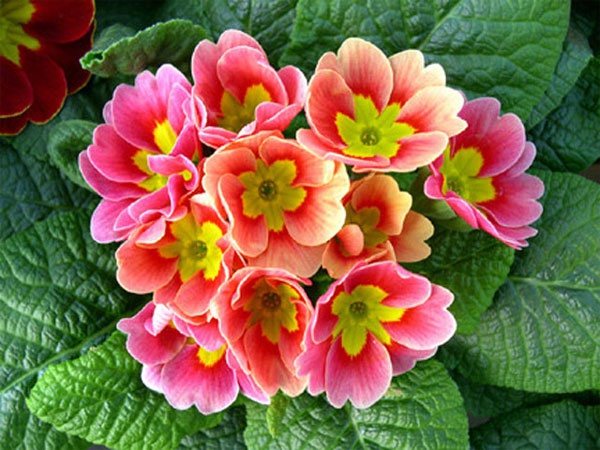

The cultivar forms reddish-orange-pink flowers
Diseases
Let's consider the main diseases of flowers and their causes.
- Gray rot - occurs in conditions of excess moisture, manifests itself in the form of weeping spots on the leaves and a gray bloom. Fungicides will help fight defeat.
- Ramulariasis - occurs when the plant is kept for a long time in conditions of cold and high humidity. It is characterized by the appearance of light yellow spots on the leaves, followed by the formation of holes in their place. Fungicides are used to fight the disease.
- Leaf spot - occurs in conditions of high humidity. Brown spots appear on the leaves. The affected leaves must be removed, the soil must dry out and the plant must be treated with insecticides.
Polyanthus primroses
Numerous varieties of the Primrose group are bred on the basis of hybrids between European and Caucasian primroses (P. vidgaris, P. juhae). They are characterized by single (in many cases double) flowers on elongated peduncles. Crossing P. vulgaris with P. veris produced the Polyanthus group with large, multi-flowered inflorescences on a prominent peduncle.
The seeds of these primroses are often sold as mixtures. There are both varieties for open ground, which are more or less winter-hardy, and those intended for greenhouses (as a rule, with larger flowers of a very bright color). The latter are sold in shops in pots as a gift. Florists of the middle lane often complain that such primroses do not winter well in the open field. Many varieties are propagated vegetatively. The best ones are listed below.
Primrose
The cultivar blooms in spring. Semi-green plants with a height of 10-15 cm and a diameter of about 25 cm.
The variety blooms in spring
"Alan Robb"
Terry flowers are delicate apricot;
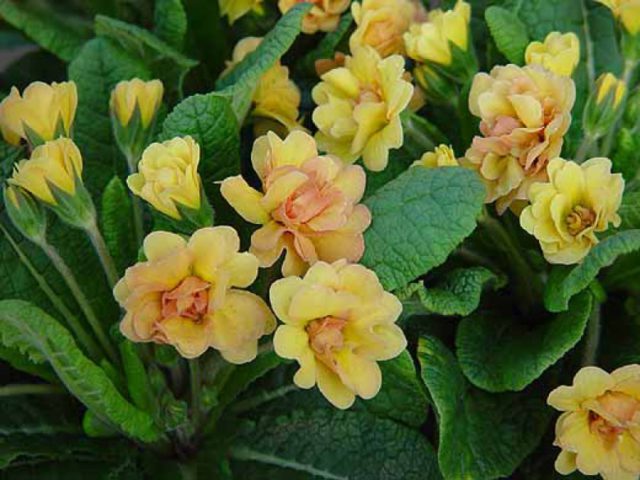

Terry flowers, delicate apricot
April Rose
Double dark pink flowers;
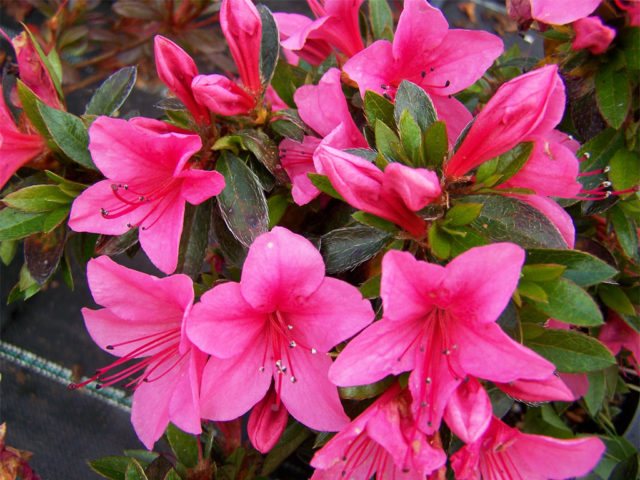

Double dark pink flowers
"Captain Blood"
Terry blood-red corollas.
Terry blood red corollas
"Chocolate Soldier"
Terry corolla varieties from chocolate to purple with a golden edge;
Terry corollas ranging from chocolate to purple with a golden edge
Corporal Baxter
Corollas are terry, velvety, crimson.
Corollas are terry, velvety, crimson
Dawn Anselp
The variety resembles the multi-flowered primroses from the Jack-in-the-Green group: the corollas are white, double, as if surrounded by collars of small green leaves.
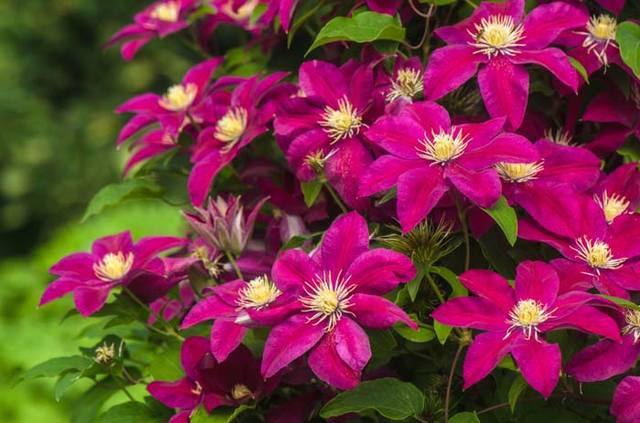

Dawn Anselp
"Eugenie"
The variety has terry corollas, dark blue, and purple closer to the throat;
The variety has terry corollas, dark blue
"Freckles"
The variety is characterized by double, dark red vechiks with white specks;
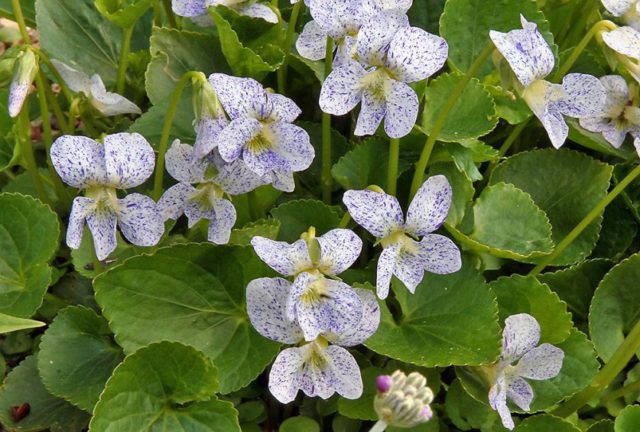

"Freckles"
Groeneken's Glory
Bright bluish-pink with green fauces;
Groeneken's Glory
"Ken Dearman"
Terry, yellow at the base of the limb and reddish-orange corollas to its edges;
Terry, yellow at the base of the bend and reddish-orange corollas to its edges
"Lilian Harvey"
Terry, purple corollas;
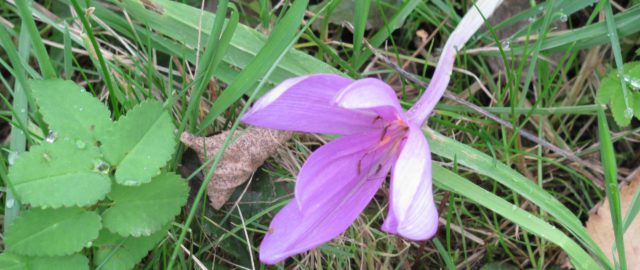

"Lilian Harvey"
"Marianne Davey"
Terry, pale yellow and cream corollas;
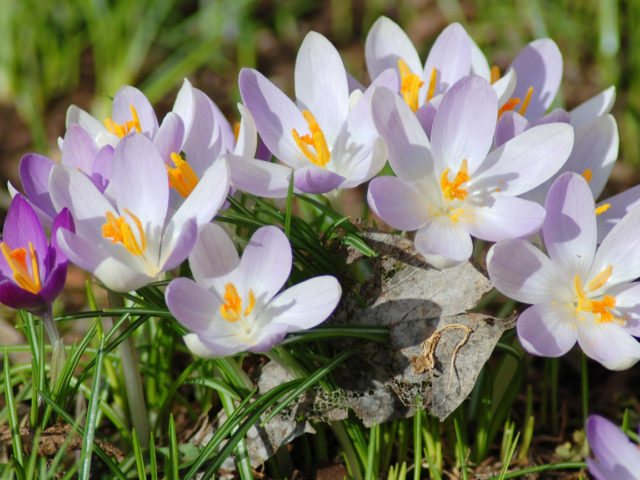

"Marianne Davey"
"Marie Crousse"
Terry, purple corollas with a white edge;
"Marie Crousse"
Polyanthus
Blossom in spring. Semi-green plants 15-20 cm high and about 25 cm in diameter.
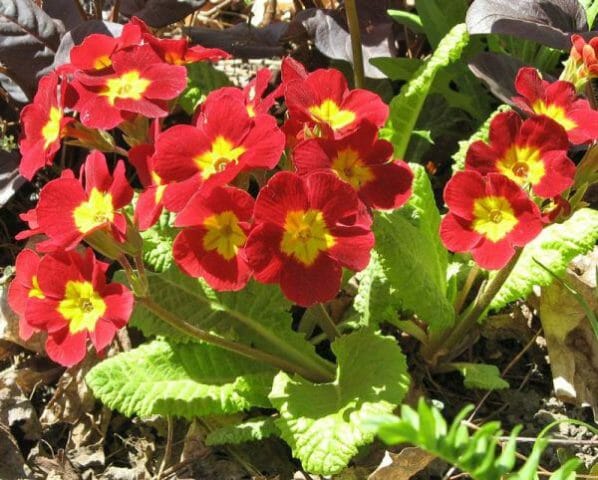

Polyanthus
Growing
Potted primroses
They need pots with a diameter of 13 cm with peat or universal soil for flowers, regular feeding and protection from the hot sun.
Alpine primroses
Plant European species in a very well-drained flowerbed with lots of humus or in pots in a sunny spot. Most Asian species need richer, moist, but still well-drained soil, rich in leafy or other humus, and partial shade. In pots, these primroses prefer peat or humus soil mixture, and European species prefer earthen. In both cases, good drainage is essential. Feed with liquid fertilizer monthly during the growing season.
Curb-swamp primroses
Plant in any moisture-retaining soil that is rich in humus. In dry places, they need partial shading, in relatively damp places, more sun. Candelabra species usually require more moisture than others, and watering in dry weather. Grow P. florindae, P. rosea and P. sikkimensis in very moist, even marshy soil.
Polyanthus (primrose and polyanthus)
Plant them in early spring in a soil rich in organic matter (well rotted manure, compost, or leaf humus).
In hot places, partial shading is desirable. More often - at least once every two years - divide the bushes and transplant the division to a new place.
For indoor cultivation, the ideal option is peat soil. Place the pots on a light, cool, well-ventilated windowsill and keep the plants humid.
Auricula
Dilute alpine, terry and exhibition auricles in pots with earthen soil mixture, adding crushed stone to it to improve drainage. Water abundantly during fall and spring growth periods without splashing water on the plants. Transplant in early summer. Provide partial shade in hot weather. Plant curb and relatively stable alpine auricles such as "Argus", "Lisa" and "Mark" in humus-rich, well-drained soil in sunny places (in hot conditions - slightly shaded).
Forcing primroses
Two-year-old seedlings are suitable for quick forcing. Seated in small pots, without violating the integrity of the earthen coma, and grow in the cool (for example, a greenhouse). It is advisable to finish the distillation before frost.
Further care is extremely simple: it is enough to lower the air temperature to + 8 ˚C and exclude watering. Early February primroses provide access to light at the same temperature. Now they should be watered. By the middle of the month, primroses will bloom.
Types of home primrose with photos and names
The genus includes about 500 plant species. Only a few of them are grown indoors.
Primula Obconica or reverse conic (Primula obconica)
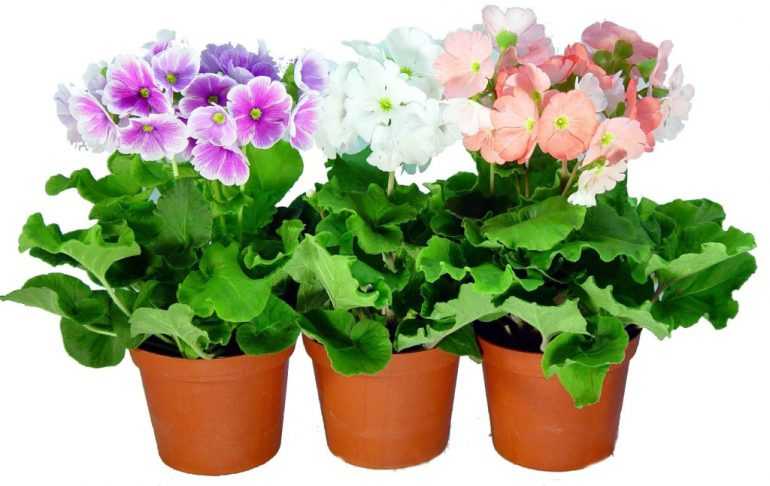

Tall (up to 60 cm) herbaceous perennial with a lush rosette of long-petiolized large (length 10 cm) rough heart-shaped leaves with a wavy edge, shape. It blooms, forming umbellate inflorescences of buds of various colors, 3-4 cm in diameter, exuding a delicate pleasant aroma.
Primula Malakoides or mallow (Primula malacoides)
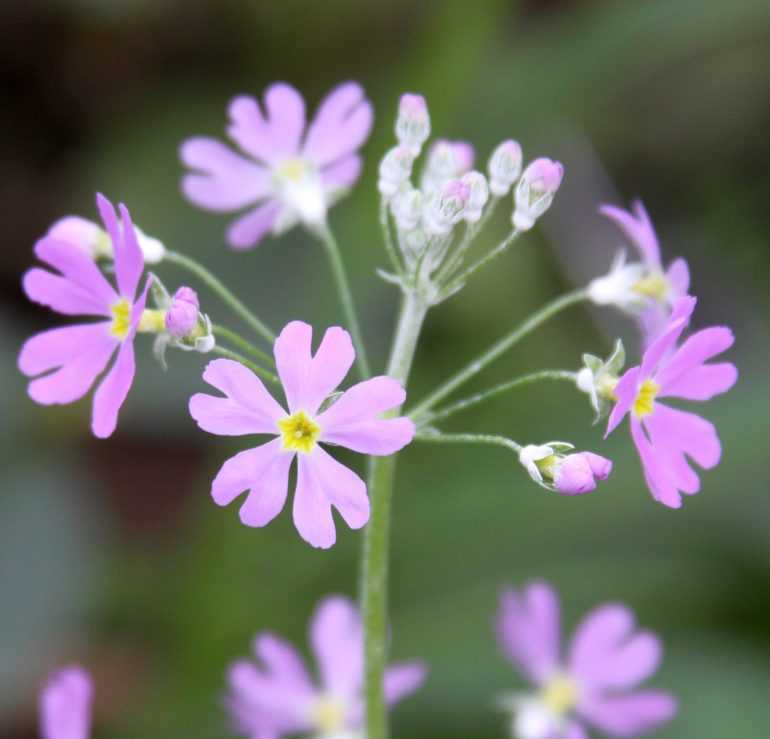

An annual herb up to 40-45 cm high with a dense elastic rosette elongated-oval, with a jagged edge, leaves. It begins to bloom in late autumn, forming on one plant up to 8 tall peduncles ending in whorls of tiered inflorescences, consisting of several dozen (up to 45) small (up to 1.5 cm in diameter) buds of pink, red or white shades, often interspersed, strokes, yellow core.
Common primrose or stemless (Primula vulgaris)
It is represented by a large number of hybrids with a dense rosette of elongated-oval wrinkled leaves, in the central part of which feathery venation is clearly visible. It blooms in early spring, 3-4 weeks, forming low peduncles ending in single large (2-4 cm) buds of snow-white, blue-purple, red, yellow and burgundy shades. This species is more often than others offered for sale and is cultivated both as a pot culture and in the open field.
Classification
The classification of primrose is complicated by the multitude of its varieties. At the moment, 7 subgenera are distinguished:
- Sphondylia;
- Auriculastrum;
- Primula;
- Auganthus;
- Carolinella;
- Aleuritia;
- Craibia.
The Horticultural Society of Great Britain proposed a simplified classification, according to which all types of primrose are divided into three groups according to such characteristics as the shape and location of the inflorescences.
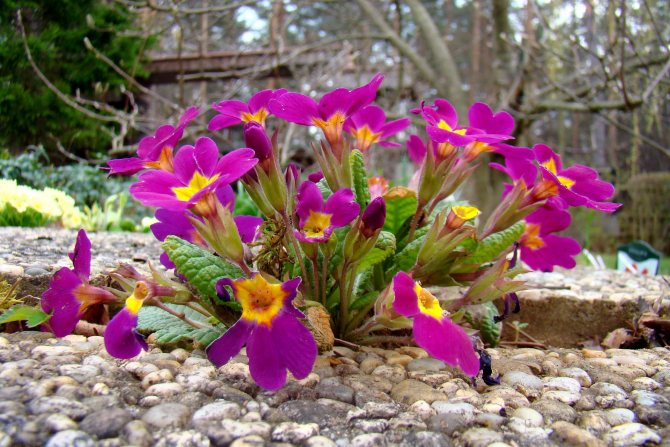

Russian gardeners distinguish the following types of this plant:
- umbrella;
- cushion;
- capitate;
- tiered;
- candelabra;
- bell-shaped.
Among them there are such unpretentious varieties that they can be planted in areas where other plants can hardly survive. A multi-colored carpet of garden primroses will delight you with its beauty every year.
Planting methods
The first time you need to buy primrose seeds, and then, if you wish, you need to collect them yourself. At the same time, however, the offspring do not always retain the varietal characteristics of the parent plant.
You can plant primrose using seeds and seedlings:
- The most unpopular way is to grow primroses from seeds. Sowing is carried out not too deeply, in pre-made grooves or in the usual superficial way. At the same time, sowing work is recommended to be carried out in the summer, providing the decorative culture not only with mulching, but also with regular irrigation measures. Thinning is carried out after the appearance of the second pair of true leaves.
- Seedling cultivation is carried out by the classical method of the frost phase or by a simplified method using low positive temperatures. It will be optimal to keep the seed at a temperature of –5 to –10 ° C for 20–30 days. Without exception, all varieties and hybrid forms of primroses, both stratified and not subjected to such a procedure, require the provision of the same temperature regime for germination - within 16-18 ° C.
Fertilizing and feeding primrose
Despite all its unpretentiousness, primroses will react well to feeding with rotted organic matter. During flowering, just before the opening of the buds, you can use an aqueous 1% solution of complex fertilizer, but if you use it when the buds are not yet visible, all the power will go to the leaves.
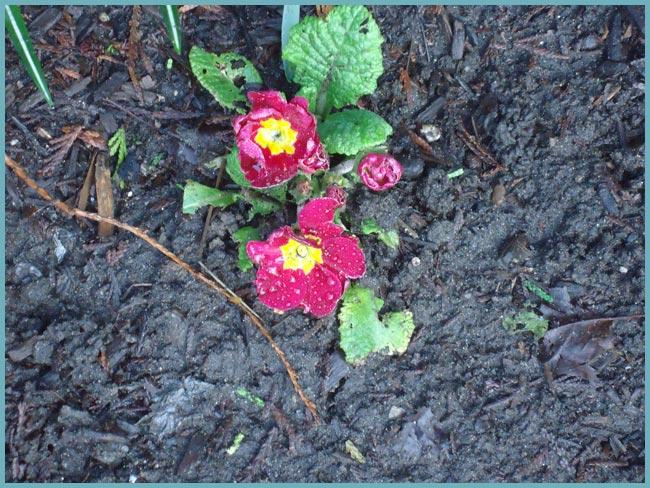

Primrose responds well to both organic and mineral fertilizers
After flowering, you can add mineral fertilizer in the form of an aqueous solution. This will help the flowers gain strength for the next year and create new flower buds.
Primrose varieties: photo
Features of growing perennial primrose as a garden crop
In the wild, primrose can be found in any wet region with fertile soil. It is characterized by a huge variety of species, some of which are listed in the Red Book of the Russian Federation. Thanks to its beautiful flowering and unpretentious care, the plant is widely used in horticulture.
In nature, primrose flowers are smaller than those of garden varieties.
Perennial primrose is a low rhizome plant with beautiful, slightly wrinkled, glossy or pubescent foliage of a round, oval or lanceolate shape. Its color, depending on the species, ranges from bright green to bronze. Edges can be either smooth or serrated. The leaves are collected in a neat compact rosette, from the center of which powerful flower stalks emerge. At their top are umbellate or spherical showy inflorescences of various colors. In some species, small flowers may be solitary. The plant has a pronounced pleasant smell. It is due to the presence of a large amount of essential oils in its foliage and flowers. At the end of flowering, fruit-boxes with small seeds of a dark brown color are formed on the bushes.
Primrose belongs to frost-resistant plants. If it is planted in open ground, then with proper preparation for wintering, it tolerates frosts well up to 30 ° C. In summer, these flowers will have a comfortable temperature of 18 to 25 ° C, while providing them with high humidity and light shading. Thanks to such characteristics, it can be grown practically throughout the entire territory of our country.But most suitable for breeding are regions in which a humid and cool climate prevails.


Garden perennial primrose is one of the first to bloom
Also, these plants can be grown at home by planting them in small flowerpots or tubs on the balcony on the east or west side. With the onset of the autumn period, the containers should be brought into the apartment and the primrose should be cared for as an indoor plant, providing it with a dormant period in the winter months.
It is advisable to place flowers in a darkened room with an air temperature of 12 to 16 ° C and water no more than twice a month. In the spring, the flowerpots need to be transferred to a well-lit, warm place, resumed regular watering and top dressing. With the onset of a comfortable air temperature, they can be taken out to the balcony again.
The plant makes high demands on the composition of the soil. It will develop well and bloom profusely only on loose, moisture and breathable, nutritious and well-drained soil. When preparing a site for planting, it is recommended to add for each square meter of substrate:
- humus - 3 kg;
- coarse sand - 10 kg;
- vermiculite - 2 kg;
- sphagnum moss - 2 kg.
The soil must be dug to a depth of about 50 cm and leveled well. The primrose has a rather weak superficial root system. Therefore, in the process of growing it, it is necessary to regularly remove weeds that take moisture and nutrients from the soil around the plants, and mulch the soil.
1. Seven Secrets of Success:
| 1. Growing temperature: even during the period of active growth, the flower needs coolness - primrose blooms best at a temperature of 13 - 16 ° C, the rest period should take place in an even cooler room at a temperature of about 10 ° C. |
| 2. Lighting: in spring and summer it is worth protecting the primrose from direct sun, direct sunlight in the evening and morning, in autumn and winter maximum light. |
| 3. Watering and humidity: Abundant and regular bottom watering during the period of growth and budding should be replaced by a limited introduction of moisture after flowering and as the green mass dies. Air humidity is high. |
| 4. Features of the: primrose can be used for forcing - getting a lively blooming bouquet for any desired holiday. |
| 5. Priming: perfectly drained, nutritious and acidic or neutral substrate with a lot of organic matter. |
| 6. Top dressing: in spring and summer with fertilizers with a high phosphorus content or organic matter. During the rest period, feeding is stopped before the start of new growth. |
| 7. Reproduction: division during transplantation, seeds, peduncle trimmings. |
Botanical name: Primula.
Primula flower - family... Primroses.
Homeland of the plant... Asia, Europe.
Description... Primrose or primrose is a very pleasant perennial herb that amazes with a variety of shades of flowers.
Plants form basal leaf socket.
Leaves light green, elliptical or lanceolate. The leaf stalks, depending on the variety, can be quite long or absent altogether. The leaf blade can have small denticles along the edge or be entire. The leaf veins are distinct and often sunk deep into the leaf surface. The tops of the leaves often have a thin pubescence... The underside of the leaf blades of some varieties is colored in a lighter shade.
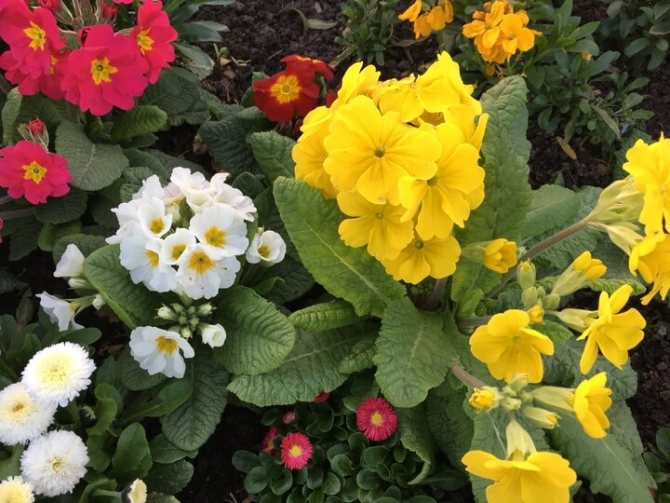

During the flowering period, the plant throws out pedunclesthat carry on the top several brightly colored flowers... The height of the peduncles varies greatly depending on the specific variety - it can range from 1 to 25 - 30 cm. Shades of flowers include almost the entire color gamut. There are plants with buds colored in 2 - 3 different shades. The center of the flowers is often yellow or orange.
After flowering on the bushes appear seed pods with very small brown seeds.
Many varieties of primrose emit a distinctly pleasant aroma during the flowering period.
Currently, many varieties of this plant are known, differing in color of flowers, flowering time, height of peduncles, color and shape of leaves, exist re-flowering varieties.
↑ Up,
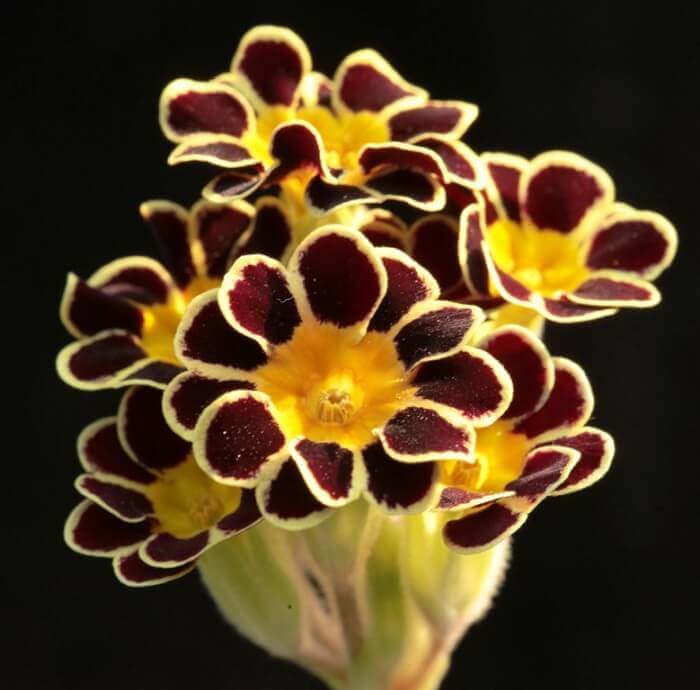

Height. 20 - 30 cm.
Useful properties of homemade primrose
In homeopathy roots and ground parts are considered healingwhich are rich in phenolic glycosides, ascorbic acid and carotenoids.
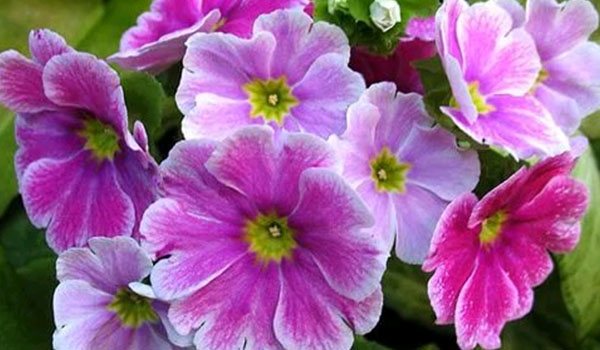

This primrose is a storehouse of essential substances.... The tops of the plant are full of vitamins. After a long winter, it is an excellent remedy for vitamin deficiency.
The home primrose is also known as the "flower of the twelve sorcerers". Its leaves contain large reserves of ascorbic acid. It perfectly strengthens the immune system. Also in them a lot of carotene... It does wonders for our skin and hair.
Even the roots of this primrose are very beneficial. They are a source of saponin, which can be beneficial for the human body as well.
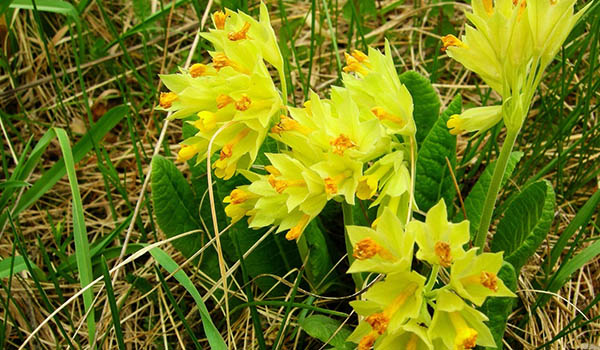

Saponins have a truly wide range of useful properties:
- are a powerful immune-boosting agent;
- have an invigorating and stimulating effect;
- has a positive effect on libido and potency;
- accelerates the metabolism of glucose and cholesterol in the blood;
- is hepatoprotective;
- the roots contain beneficial essential oils.
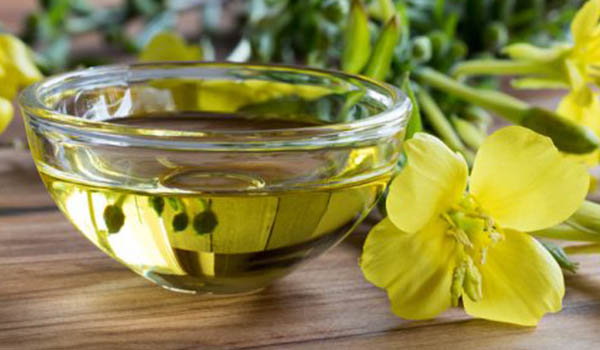

Primrose leaves act like a plaster for cuts... The plates have the ability to relieve pain and aid in the rapid healing of wounds.
There are also different signs and superstitions regarding this flower. It is believed that if there is a primrose in the house, then the family will be rich and happy... Growing this beauty in an apartment will help prevent troubles and quarrels.
This video will tell you about primrose and its beneficial properties.
Reproduction of primrose
Many do not know how to propagate a flower so that it is healthy and beautiful. In fact, everything is very simple. Exists several options for how to grow new copy. Among the many methods, the most popular are: division of the mother bush, seeds and cuttings. Occasionally, the leaf propagation method is used. This is a rather laborious process that takes a lot of time and effort.
Dividing the primrose bush
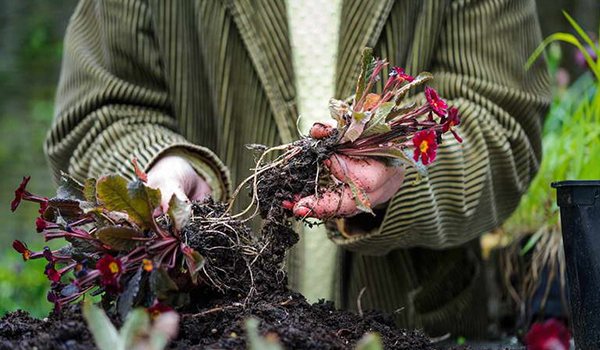

This procedure is combined with a transplant. New rosettes are separated from adult specimens. Before planting a bush, you need prepare the container and soil... You can prepare the substrate yourself or buy it in a specialized store.
Important! For successful adaptation, the specimen is planted along with the earthen lump in which it was before.
Seed propagation
To get them, they resort to artificial pollination. Planting ready-made seeds is carried out in the summer.... This is best done in wide bowls of medium depth. After sowing, the container is covered with foil. Seedlings can be obtained only at a temperature of + 16 - + 17 ˚C. The first shoots will appear in 14 days.
This video explains how to properly plant primrose seeds.
Propagation by cuttings
Leafy cuttings will serve as an excellent breeding material. Root them in a greenhouse or in open soil. Be sure to plant them in partial shade.... The whole process will take 15 to 20 days. The sockets that put the roots in are not taken out of the greenhouse for the winter. Only in the spring are plants transplanted to the place where they will grow constantly.
This method reproduces the toothed primrose. Choose lush bushes with powerful rosettes and strong roots. In the upper part of the rhizome, longitudinal cuts are made (approximately 1.5 cm). This will form the kidneys much faster. Next, the finished cuttings are placed in soil mixed with river sand. The root must be buried 3 cm... Now all that remains is to water and loosen the aisles.
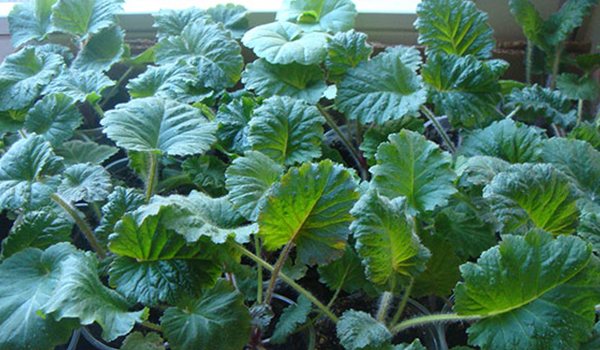

Cutting gives in a short time a lot of material suitable for planting. Unfortunately, this method not suitable for all types.
Primrose care at home
Primrose refers to unpretentious flowers, any beginner in the flower business can grow it. We will introduce you to some of the features of growing it at home.
The temperature and location of the primrose in the apartment
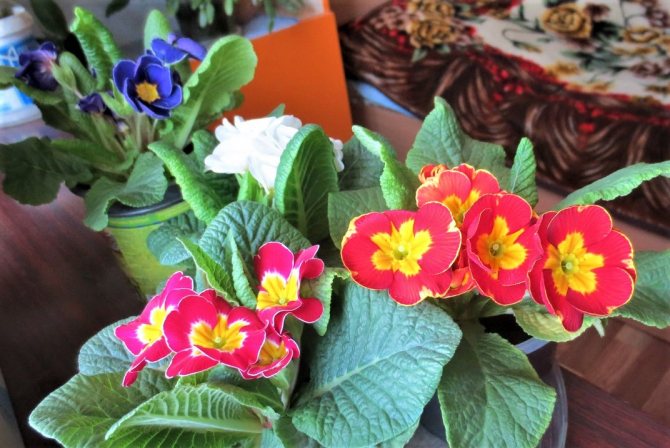

For comfortable maintenance of primrose in room conditions, a low air temperature is needed. Maximum 18 - 20 gr. During flowering, the temperature should be even lower, 12-15 grams. Typical room temperatures are much higher. Therefore, from early spring to mid-autumn, when the outside temperature allows, we recommend taking this plant out into the open air of a loggia, balcony or veranda. After flowering, you can even transplant primrose into the ground in your garden plot, somewhere under the crown of trees. In the winter months, it is better to keep the primrose at home on the windowsill, away from the radiator and closer to the cold glass. For this, it is better to choose window sills of northern, eastern or western directions.
In temperate climates, primroses are not afraid of wintering in the garden, they winter calmly without much shelter. So, if you have a hybrid variety, you decide whether to bring the primrose into the room or leave it to winter outside.
Lighting
Primrose refers to light-loving plants. Its place should be located on a well-lit windowsill. Primrose should be protected only from direct sunlight - burns can destroy the delicate foliage of the plant. Diffuse lighting will be just right. In the winter months, if you have not sent the primrose to the basement to sleep, you will have to use additional lighting (phyto lamp or fluorescent lamp).
It may be interesting: Bauhinia: we grow an orchid tree at home
Air humidity
Primrose does not like too dry air. In moderate to high humidity, it feels great. If you notice that the tips of its leaves have begun to dry, then the air in the room is too dry. Start spraying the plant with warm, standing water. Try to moisturize only the leaves and stems of primrose, do not get water on its flowers. Put containers with primroses in trays with wet expanded clay - this will also raise the humidity in the room and will maintain the necessary soil moisture in the flower pot.
Watering
Proper watering is very important for the health and blooming appearance of primrose. Water the plant sparingly and regularly. During flowering, the soil should be slightly moist all the time. We recommend maintaining constant humidity using pallets filled with wet expanded clay, moss or sand. Primrose pots will feel good on them. Remember to only add water to the sump if necessary.
After flowering, water the plant only when the topsoil in the pot dries up. Do not pour water on the leaves. Use only settled water at room temperature. During the rest period, primrose should be watered less often and less abundantly so that the soil does not sour and the root system does not rot.
With a lack of watering, another problem may happen - the soil with the root system will dry out, and the stem may die.
The soil
The soil for growing primrose should contain peat, sand, leafy and soddy earth in equal proportions. Acidic soil is not suitable at all. If you will use purchased soil for primrose - pay attention to this. Geranium potting mix is good.
Fertilizers and feeding
The plant does not tolerate excess salts in the soil. Therefore, it should be fertilized very carefully with fertilizers for decorative flowering indoor plants. The doses indicated on the packages should be halved. Fertilizers are applied from February until the end of flowering. Enough once every two weeks. During the conditional rest, the plant is not fed.
Transplant primrose and pot
We recommend replanting perennial primroses no more than once a year. Either in the fall or early spring.During flowering, primrose is not transplanted! The pot must be prepared a little larger than the previous one. It should be wide, but not deep, since the primrose root system is shallow. Put a 2 cm layer of drainage on the bottom (expanded clay or pebbles), add some fresh soil. Remove your primrose from the old pot along with the root system and gently transfer to the new pot. Fill the empty space in the container with the potting mix, shaking it occasionally to fill any voids inside the pot. Water and replace.
Primrose features
This genus is one of the most numerous. According to various sources, it unites 400-550 species. However, in the wild, even today, you can meet such species that have not yet been described. So, in Europe there are 33 species, in North America there are only 2 species, and in Java only 1, it also grows in several species in Africa and South America, and more than 300 species can be found in Western China, Asia and the Himalayas. Such a plant prefers to grow in places with high humidity, for example: on the shores of mountain rivers, along streams, and also in meadows.
Under the ground, such a flower has a rhizome with roots hidden. The root rosette includes dissected or simple sheet plates of an oblong-oval lanceolate shape. There are both sessile leaves and petiolar ones. You can find both wrinkled leaf plates and leathery ones, which have a high density and have a greenish-gray tint (it seems that they are slightly covered with wax). Peduncles are rather long and have no leaves. Flowers can be either single or be part of inflorescences that have the most diverse shapes, for example, spherical, tiered, umbellate, pyramidal, cushion, and bell-shaped. The flowers are tubular and have a funnel-shaped or flat limb. The fruit is an achene, which has the shape of a ball or cylinder. Garden primrose is found both annual and perennial, and such a flower can also be grown indoors.
What problems do gardeners have with growing these flowers
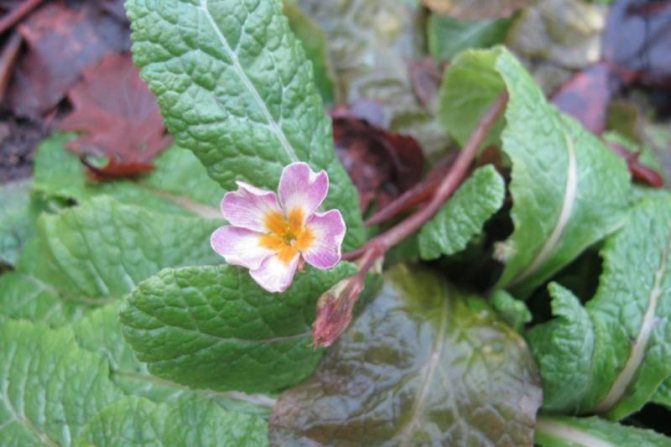

With improper care, primrose can bloom poorly, leaves can become yellow or rusty spots.
Ornamental culture at the stage of active vegetation needs coolness. During the period of the most intensive growth of the root system and the setting of flower buds, in hot and dry weather, it is recommended to minimize the negative influence of the sun by shading and intensive watering. Dryness at the stage of intense evaporation and in the absence of proper irrigation measures can cause the death of the plant.
Primroses are demanding on the structure of the soil, and not on its fertility. At the same time, it is important to ensure sufficient respiration for the plant root system. It is very important when choosing a planting and growing site to drain any low-lying areas, adjusting their structure. Clay soils should be loosened by adding sand, and too depleted soils should be enriched with high moor peat and humus, without neglecting the introduction of organic matter.
The biological feature of the growth of any primroses, including primrose, is a bulging rhizome, as well as a rather rapid, active growth of an ornamental bush. It is for this reason that it is necessary to replant the plant when it thickens too much. It is advisable to perform the procedure every four years. Otherwise, primrose can grow or die completely.
Primrose: combination with other plants
Primrose perfectly coexists with any spring flowers
As neighbors, primroses are almost ideal, because for the most part these are delicate plants that are simply not able to crush a neighbor. They will grow where there is space without displacing other crops from the garden.It is necessary to choose neighbors for this flower from the same lovers of humid shaded places.
Pest control
Primrose doesn't have that many. One of the advantages of this flower is that it is enough to regularly process it with a weak solution of nitrafen (1%) so that the plant is not attacked by biological pests and infections.
A systematic examination of the primrose will allow you to keep it on the site for more than one season. But if the slightest signs of disease are detected, it is necessary to immediately get rid of its infected parts.
You should know that primrose is very convenient as a garden ornamental plant and for one more reason. It is absolutely inert towards neighbors, and therefore the flower can be planted anywhere on the territory, if it is suitable for growing it. Minimal care, a combination of several varieties in one area - and the primrose will decorate it throughout the summer season.
Perennial garden primrose - cultivation and care
Primrose, in its bulk, is a perennial plant, occasionally there are biennial and annuals. Differs in compact size, the height during the flowering period does not exceed 50cm. The rhizome is short, horizontal, with numerous thin and succulent roots. Pollinated by insects. Honey plant. It is widely used in medicine in the form of tea for vitamin deficiency, in the form of a decoction for colds, migraines, neuralgia, gout and rheumatism, for coughs. Alcoholic tincture of flowers is used as a sedative for insomnia and overexcitation. The leaves and stems are edible and can be added to salads and cabbage soup.
Primrose became widespread as an ornamental plant. It is about this application of it that we will talk today. There are at least 390 species of primroses, conventionally divided into 38 sections, growing mainly in temperate climates. I will introduce you to some of them:
Section of powdery primroses (Fariaosa, Aleuritia). Flowers with white or yellow powdery bloom. Flower petals are shorter than calyx leaves. The colors are mostly yellow or white, lilac, reddish-purple. Grown as biennials. Most of the species are native to Asia. The best places to grow are moist, well-drained, humus-rich soils, in the sun or in partial shade. In winter, plants need to be covered. Landings are carried out near water bodies, on shady rocky hills. This is the most numerous section and includes the following types:
- Norwegian. Perennial herb 10-20 cm tall with leaves collected in a basal rosette. The flowers are purple or pink, collected in 3-5 in simple umbrellas on long stalks. Blooms in places of growth in June, early July.
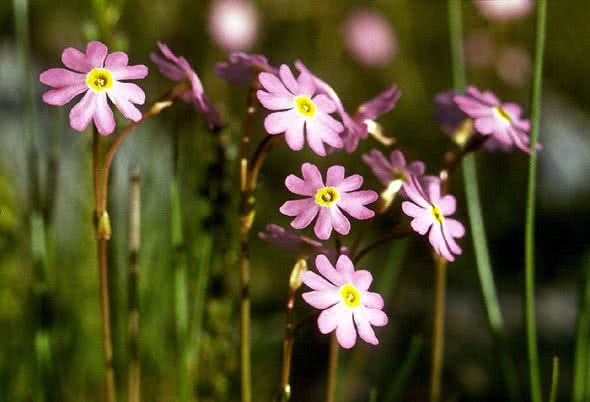

- Siberian. Perennial up to 25 cm high, forms rosettes of entire or slightly toothed leaves, sharply narrowed into a petiole. The flowers are bright pink with a diameter of 1.8 cm, sometimes with a purple tint. Blooms in June for 20-25 days. Propagated by seeds. In Moscow, hibernates under cover.
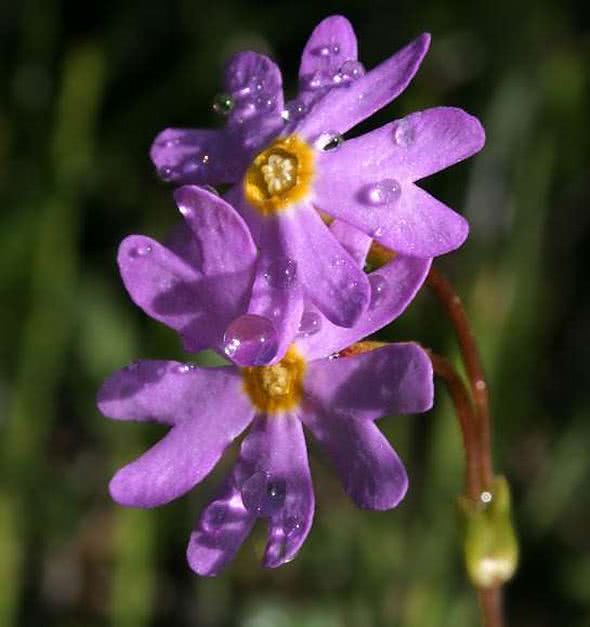

- Darial. It grows only in the Caucasus. Leaves are thin, drawn into a winged petiole. Arrow up to 25 cm high. Umbrella 2-15-flowered; corolla carmine or pink, up to 1 cm in diameter. Blooms in June for 25-30 days. In Moscow, hibernates under cover.
- Floury... It is widely distributed in the northern regions of the European part of Russia, in the south of Siberia, the Far East, in the mountains of Western Europe, Northern Mongolia. As a rule, it grows on the northern slopes of mountain boggy pastures. Accordingly, the requirements are wet and shaded areas. Floral arrows 10-20 cm high, with a whitish bloom at the top. Blooms from late April - early May for about two weeks, sometimes blooms again - in September. The leaves remain green until late autumn, and some even until spring.
- Thick-leaved. The plant usually has a white powdery bloom. Leaves are sharp-toothed. The arrows grow up to 12 cm high. The umbrella has 3-10 flowers with a lilac-pink corolla, up to 1.5 cm in diameter.Primrose blooms from April for 20-25 days. In Moscow, it can spend the winter under cover. Used for curb and carpet plantings.
- Haller. The flowers are purple, with a long tube up to 2-3 cm, two to three times the length of the flower calyx. A flower up to 2 cm in diameter. Flowers are collected in 2-12 pieces in an umbellate inflorescence on a peduncle, up to 20 cm in height during flowering, and by the time of fruiting it can reach 30 cm. Blooms in May. This primrose is grown as a biennial plant.
- Scottish... Probably the smallest of the primroses. It is so tiny that a single plant may not be noticed.
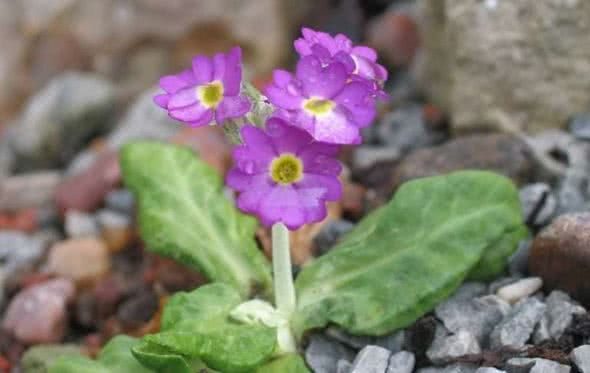

- Cold... A very common culture with oblong or oblong-spatulate leaves, collected in a basal rosette up to 15 cm in diameter. Peduncles are thin, up to 30 cm high. Flowers are small, pink-purple up to 1.5 cm in diameter, collected in 6-12 in an umbrella-shaped inflorescence. Blooms from the end of May 25-30 days. In the Moscow region, it hibernates under cover.


- Snowy. Perennial plant up to 20 cm high. Leaves are oblong-lanceolate, narrowed into a winged petiole, serrated along the edge. Flowers pink-purple up to 1 cm in diameter, collected in 8-10 umbellate inflorescences. Blooms in May for up to 30 days. In the Moscow region, it can winter under cover.
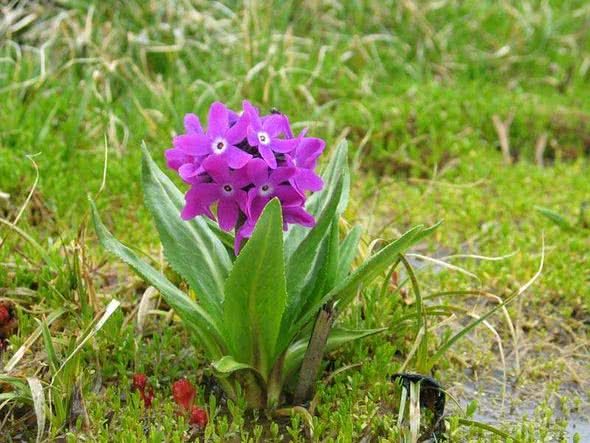

- Turkestan primrose. Perennial. Tall, vigorous plant with a white powdery bloom at the base. Leaves are elliptically oblong or broadly lanceolate, acute or obtuse, gradually drawn into a winged petiole. Arrows up to 15-30 cm high. Blooms in June-July.
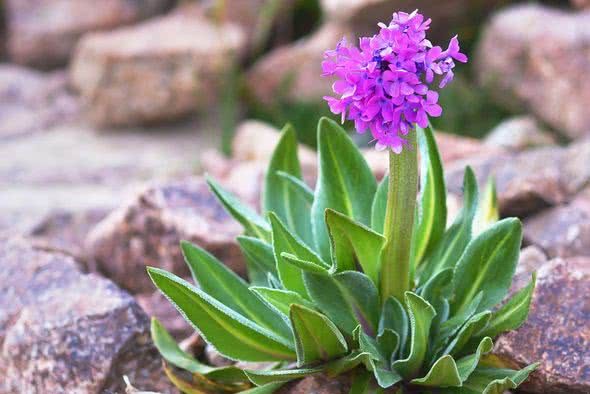

- Hungen. The plant is native to China. Arrow up to 30-40 cm high. Leaves glabrous, light green, oblong spatulate. Flowers 6-8 in whorls up to 1 cm in diameter. Blooms from June for 25-30 days. In the Moscow region, it hibernates under cover.
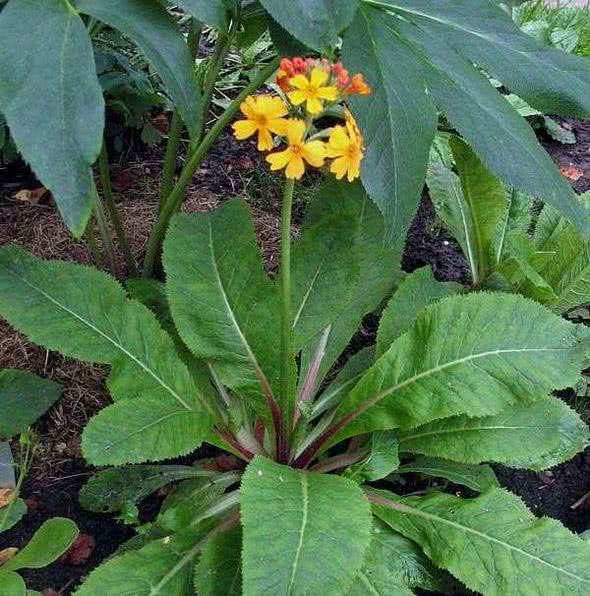

- Fine-toothed alpine... A plant with a mealy bloom. The leaves are rounded oval, toothed. Arrow up to 40 cm high. The inflorescence is multi-flowered, umbellate, often forms 2-3 tiers. The flowers are fragrant. The corolla is almost white with a wide, deeply dissected limb, up to 3.5 cm in diameter. It blooms for a long time, from June for 50-55 days. In Moscow, it can winter under light cover.
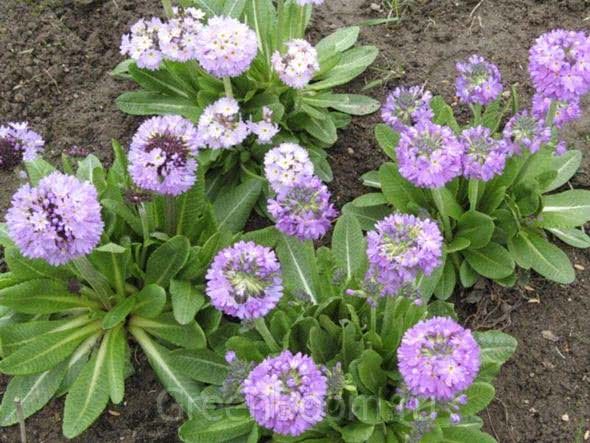

Section auricles, or auriculastrum (Auricula, Auriculastrum). Plants in this section are undersized, with juicy and leathery leaves, as if sprinkled with a mealy bloom. The flowers are multicolored from pink to purple, often with a white eye. Many varieties have been bred with very different flower colors. Primroses from this section are propagated by seeds, which are sown in autumn in October - November. Many species do not fully replicate the properties of their parents, so they are isolated and pollinated artificially. It is recommended to freeze seeds planted in spring by covering the pots with snow for several days. After flowering, the bush is divided. Low-growing varieties are propagated by segments of rhizomes. The section includes types:
- Carnioli. Leaves are oblong or oval, petiolate. The arrow is 8-25 cm high. The corolla of the flower is pink, 14-25 mm in diameter. Bloom from May to 25 days. It can hibernate only under cover. It is used for curb landings.
- Ear, or auricula. Leaves of primrose auricular evergreen, dense, leathery up to 20 cm long. Yellow flowers up to 3 cm in diameter. Hybrids have a variety of colors. Some of them have 3-4 colors arranged in regular circles. There is usually a yellow eye in the center of the flower. Flowers in inflorescences up to 20 pieces on elastic peduncles up to 25 cm high. Blooms from April to June for about 40 days. Biennial plant, abundantly covered with powdery bloom. The root system is located close to the soil surface.
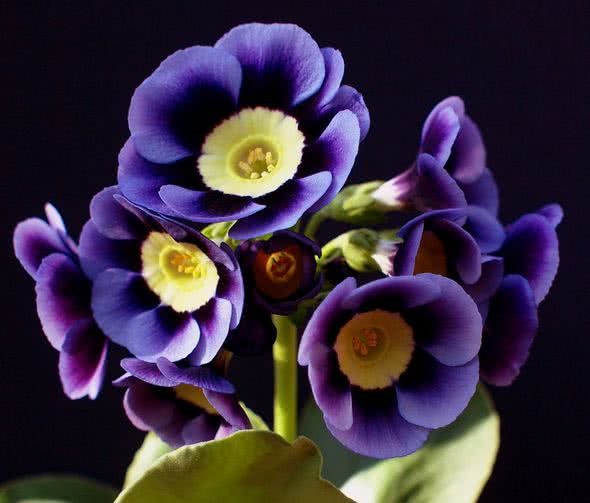

- Pubescent. Under this name, large-flowered hybrids are combined, obtained with the participation of primroses auricular, coarse-haired, sticky, hairy. These plants are usually cultivated under the general name of auricles.Plants are winter-hardy, tolerate well the climate of central Russia and in its northwestern part. Some of them have hibernating leaves and do not lose their attractiveness throughout the summer. They are grown on ordinary garden soil. Primrose requires a lot of moisture, especially in the spring. They grow well both in open sunny places and in partial shade.
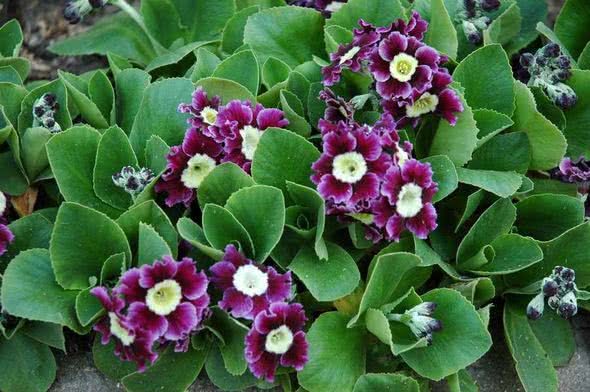

This section also includes:
- Coarse-haired
- Edged
- Delecluse
- Shaggy
- Small
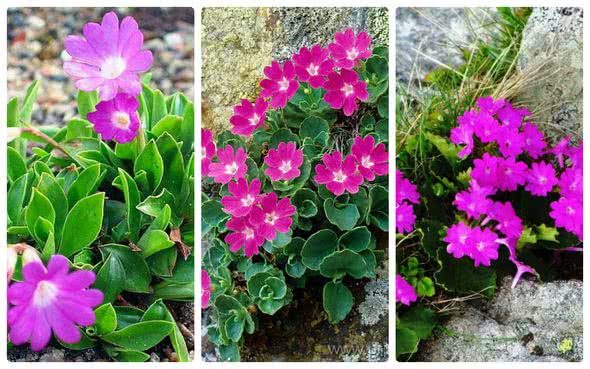

Section Muscarioides. Includes 17 species from the Himalayas, Tibet and western China. Most of the cultivated species are biennials. Seeds are usually sown annually (like other biennials). The best place to grow is partial shade. These species require a lot of moisture during the growing season, and in the autumn-winter period, on the contrary, excess moisture destroys the plants. Plants prefer fertile soils, consisting of peat, river sand and earth. For the winter, as a rule, they are covered and transferred to cold greenhouses. Propagated by seeds. The section includes:
- Vialya
- Muskarevidny
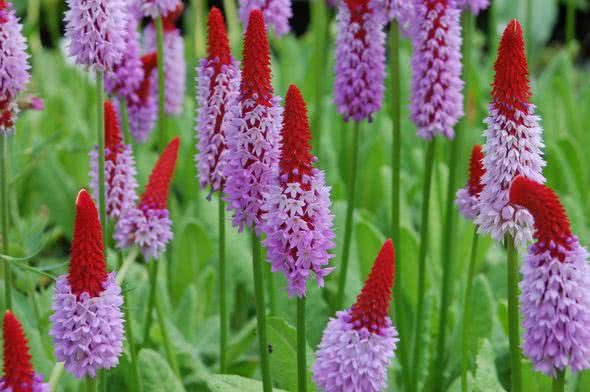

Section of candelabra primroses (Proliferae, Candelabra). Consists of thirty species. Blossom in summer. When preparing for winter, be sure to cover. The section includes:
- Bissa
- Bulley
- Powdered
- Japanese, etc.
German breeders have systematized species and varieties according to the principle of placement and shape of inflorescences. As a result, five departments were obtained: cushion, umbrella-shaped, capitate or spherical, tiered or candelabra, bell-shaped.
Section of dentate primroses (Denticulaia). Very beautiful plants with small purple-violet flowers, collected in a capitate inflorescence. Can bloom in a leafless state. By the time of flowering, the plants grow up to 30-50 cm! They come into abundant flowering by the third or fourth year of life. Propagated by root segments. They love both sunny and shaded areas with loose fertile soil. Used for winter forcing and for cutting. These include:
- Capitate
- Fine-toothed
Julia section. Perennials with a short oblique rhizome and a bunch of brownish roots. Plant height is usually about 10 cm. The leaves are long-petiolate, light green, about 10 cm long with a petiole, and the leaf blade is about 3 cm. Early flowering, begins in April and lasts until May. Plants are unpretentious, in autumn they sometimes bloom again. These include:
- Yulia
- Pruhonitskaya
Section of cortus primroses (Corthusoides). There are 24 types. No powdery coating. Funnel-shaped flowers. These primroses are easy enough to grow when planted in humus-rich soils. Self-seeding often occurs. Looks good in the corners of a landscape-type garden surrounded by evergreen trees. They grow equally well in the sun and in partial shade. Propagated by seeds, Siebold primrose and its varieties - by dividing, pieces of rhizome. These include:
- Multi-nervous
- Cortical
- Rocky
- Siebold
- Rejected
This is only a part of the presented types of primroses. Imagine a huge number of varieties ... And how much space do they open to landscape designers? Their unusual appearance and beauty also attract the attention of amateur gardeners.
The described species of primroses take root well in the weather conditions of Russia. They very rarely freeze out and retain their decorative appearance with proper care.
How to plant and grow perennial primrose from seeds
The process of growing primrose seeds yourself is not easy at all. And if you decide to do this, then the first thing you need to prepare for is failure. No matter how scrupulously you follow the recommendations, not everything depends on you. The thing is that the seeds lose their germination very quickly. Even if they were stored in ideal conditions, the germination capacity will be lost by half by the spring.
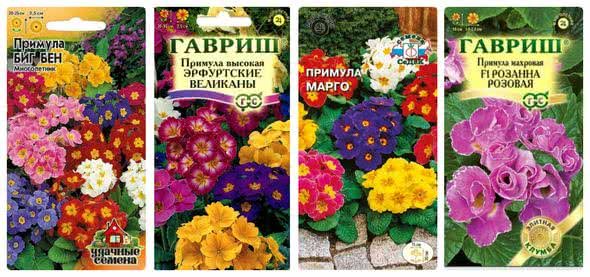

The storage temperature at +20 degrees for primroses is already considered too big. And at what temperature the seeds were stored in the online store, no one will tell you.Therefore, it is better to hurry up with sowing. But the main thing is to know that 99% success depends only on seeds, and not on the specific agricultural technology of their germination.
When to sow primrose seeds
Perennial primrose, due to its biological rhythm, imposes certain requirements on the conditions when it is grown from seeds. Considering that it begins to bloom soon after the snow melts, it is necessary to create conditions so that it is ready for this moment.
Stratification, known to many summer residents, can help in this. There are many options for this procedure, but the bottom line is that first the seeds are placed in a damp cloth until they swell at room temperature, then they are transferred to a cold place.
These actions simulate conditions similar to when the seeds are covered with snow. At home, stratification is usually carried out in the refrigerator. If you are the owner of a private house, you can carry out stratification in a cold cellar.
How to plant primrose seeds
Almost all primroses need cold stratification. This treatment mimics the natural living conditions of seeds, with natural temperature fluctuations. Do you need it for your seeds or not, read on the package, if stratification is not needed, you will simply waste time carrying out it, and this will not affect seed germination in any way.
There are two methods of cold treatment of seeds that are fundamentally different:
- Classic method with frost phase
- Simplified method with low positive temperature treatment
The classical method of seed stratification:
- Prepare a container with dry soil for planting seeds. Approximate composition: turf, peat, sand in a ratio of 2: 1: 1
- Sow on a dry surface. Seeds can only be pressed into the ground a little; they cannot be covered with earth or sand. Sowing density should not exceed 5 seeds per 1 sq. Cm. Use a toothpick or tweezers to sow.
- After sowing, it is impossible to spray the soil. Cover the containers with glass or foil and send them to a freezer with a temperature of -5 ... -10 degrees for at least 10 days, even better for 20-30. Or put the containers on the street (if it is cold), dig in a snowdrift.
Simplified seed stratification method:
Instead of freezing seeds, you can use the method of more gentle stratification, at low but positive temperatures. With this method, the growing process is accelerated, as opposed to the likelihood of success. It goes as follows:
- Spread the primrose seeds over the top of the nutrient soil
- On top, apply a layer of snow 1-2 cm thick. Or simply moisturize. When melted, the snow will draw flower seeds into the ground to the desired depth
- Cover the container with glass or a bag
- Remove the container with seeds in the refrigerator on the lower shelf, with a temperature of + 2 ... + 4 °, for stratification for 1-3 weeks
- After emergence, transfer the container to a cool place where the temperature is kept at 13-18 °
The main thing: the later you started sowing, the later the seedlings will appear.
All primroses, both stratified and non-stratified, must be provided with the same temperature for growth - from 13 to 18 degrees. Place containers with seedlings away from direct sunlight, preferably a bright place with diffused light.
It will be possible to completely remove the film or glass from the seedlings in one to two weeks. By this time, the seedlings will get stronger in order to live without shelter. Sprouts develop very slowly in the first weeks. Their rapid growth and development begins later. Until the moment of picking, the main task is accurate watering and airing.
It is better to water the plants by spraying from a finely dispersed spray bottle, trying not to soak the sprouts too much. The substrate, as in the germination stage, must be constantly moist, but not damp. Drying out of the soil is detrimental to seedlings.
When the first one or two true leaves are formed in the seedlings, a pick is carried out.Young shoots are transplanted as carefully as possible, without touching the roots, if possible, into separate cups or large containers at a distance of 5-6 cm from each other. Plants need the same care, with careful watering, preventing the soil from drying out. The active growth of primroses will begin after the pick. If development is very intensive, and it becomes cramped for them in a common container, the pick can be carried out again by seating them in separate cups.
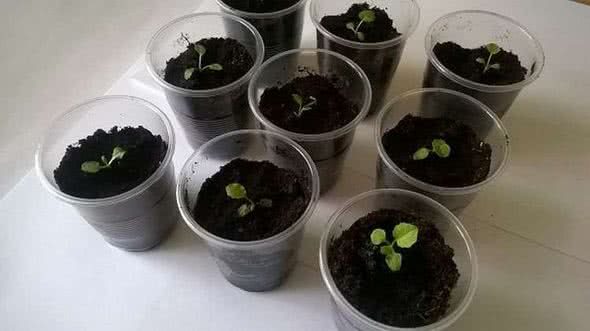

Primroses, before planting in open ground, do not need hardening, in the classical sense. Planting in open ground is carried out when the air warms up to a temperature of more than +10 degrees and the risk of night frosts disappears.
For plants, areas protected from direct sunlight are chosen, with loose, light texture and nutritious soil. But for certain species of primroses, there are non-standard conditions for development, carefully study the packaging with seeds.
When transplanting seedlings to a permanent place, be careful with the root system, trying to cause it as little harm as possible. But pay the main attention to the distance between the bushes when planting: primroses are planted so that air circulates freely between the plants, but at the same time there is no free soil between the bushes (the optimal distance is from 20 to 30 cm for large varieties and 15-20 for small varieties; at this distance, the bushes will feel free, but the leaves will not be cramped).
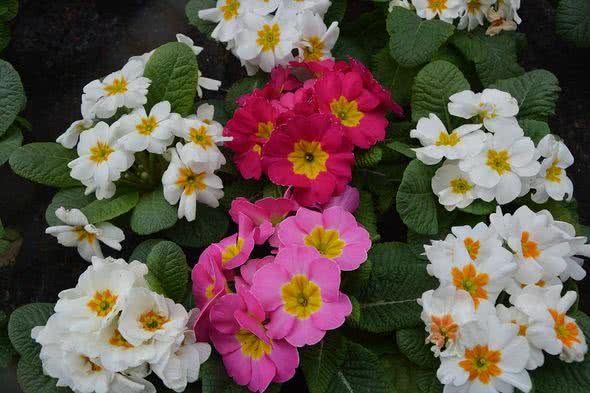

After planting, do one or two maintenance watering during drought. From the moment of active growth, add top dressing in the form of vermicompost or mullein infusion. Planting primrose, it is advisable to mulch with a layer of dry leaves about 10 cm high. In winter, such a layer will protect the plants from freezing and, decomposing, will provide food.
Diseases and pests
The primrose reacts to violations of the conditions of maintenance and care by changing its appearance and vegetation:
- leaves turn yellow primroses - very dry air, watering with hard water, stagnant moisture, top dressing using high concentration fertilizers;
- leaves rot - long-term maintenance in conditions of high humidity of air and soil, frequent wetting of leaves during watering;
- flowers fade quickly - if the air is too dry and warm (more than 20 ° C).
- does not bloom, if you spent the winter in a warm (above 20 ° C) room.
The rest of the primrose diseases are a consequence of the defeat of plants weakened by improper care of plants by fungi.
- Spotting: the development of the disease provokes excessive watering and poor ventilation of the leaf outlet when it is excessively thickened. The infection is manifested by the formation of gray spots on the peduncles and leaf blades, which are subsequently covered with plaque.
- Ramulariasis develops when the plant is kept cool and over-watered. It is diagnosed by the appearance on the leaves of rounded spots of light yellow color, which subsequently darken and rot, which leads to the death of the entire leaf, and then the plant.
Fight against fungal infections by timely removal of damaged parts and subsequent repeated treatment of the entire plant with Fundozol or Topsin solutions.
Primrose can be affected by pests: aphids, scale insects, thrips, weevils, spider mites. At the first signs of damage to insect pests, they are destroyed by folk methods, in advanced cases, insecticides are used.

